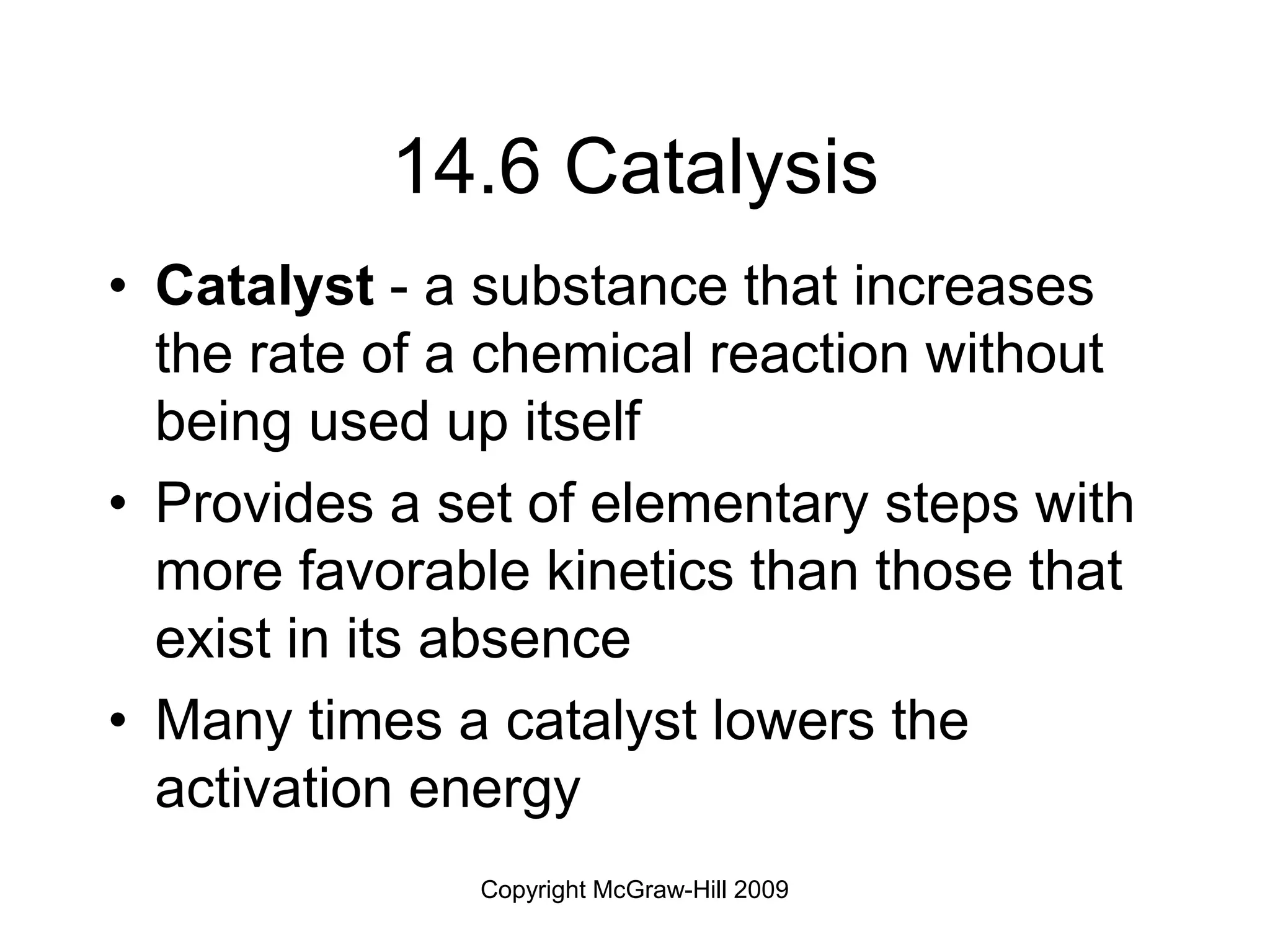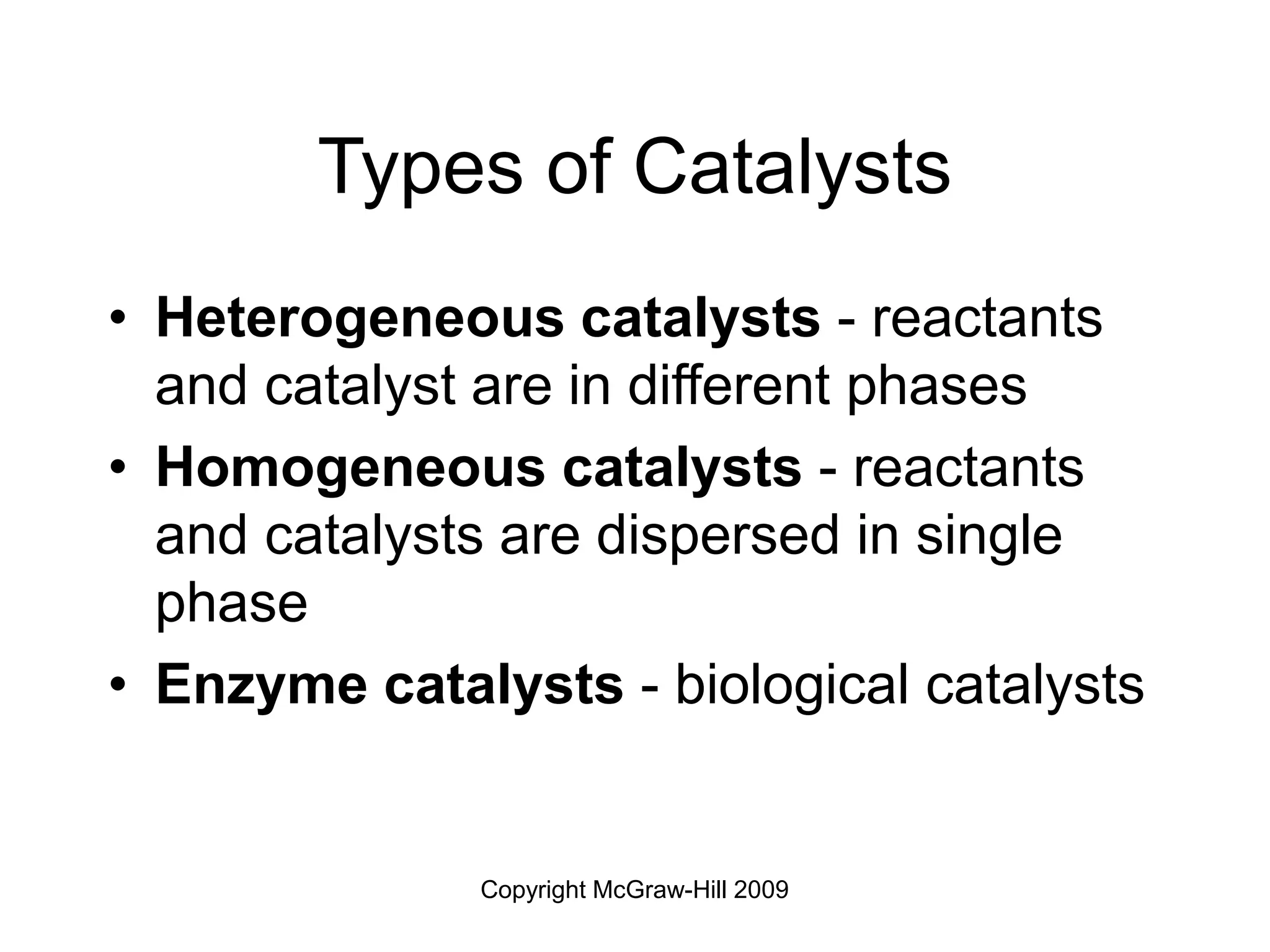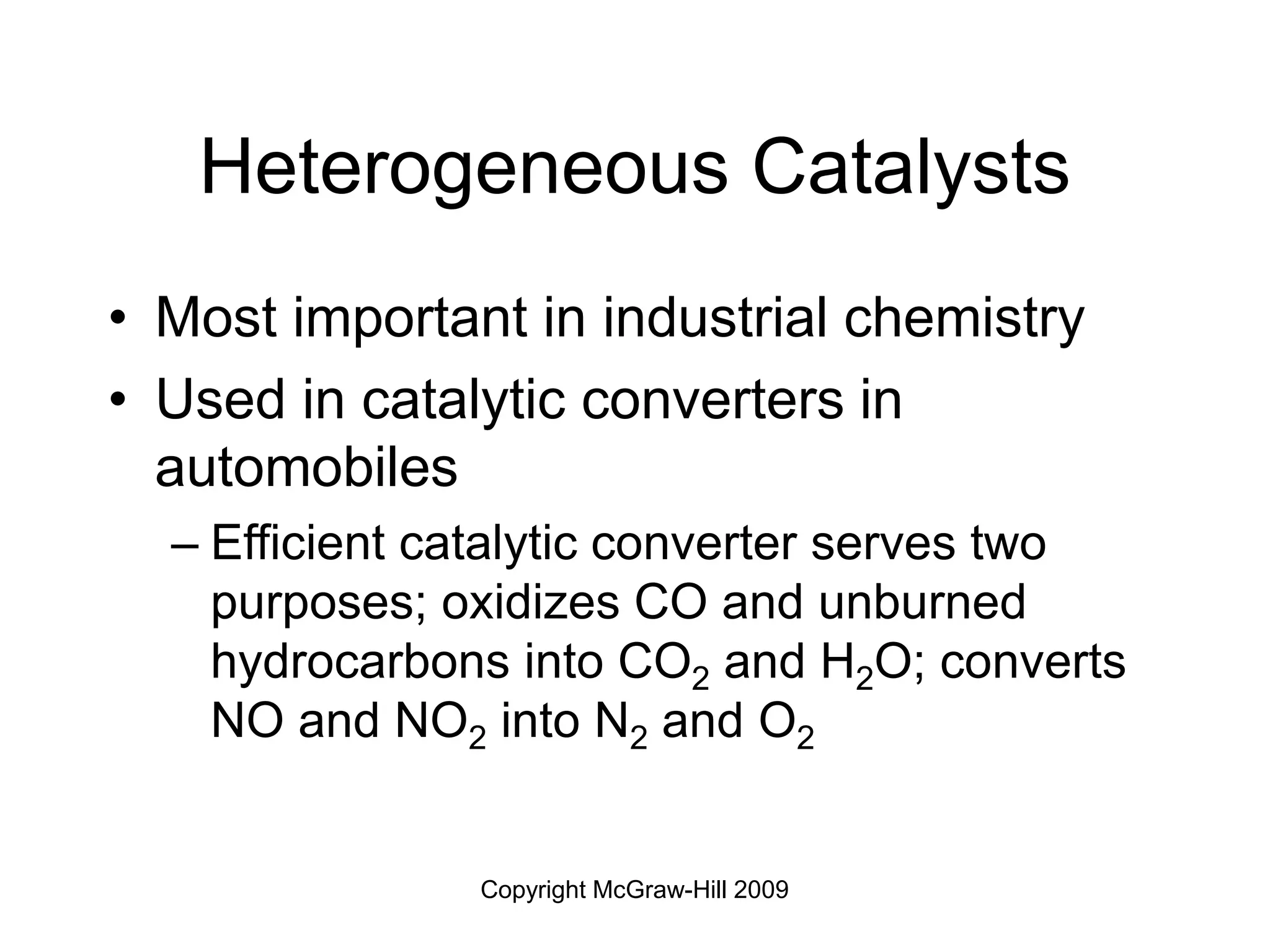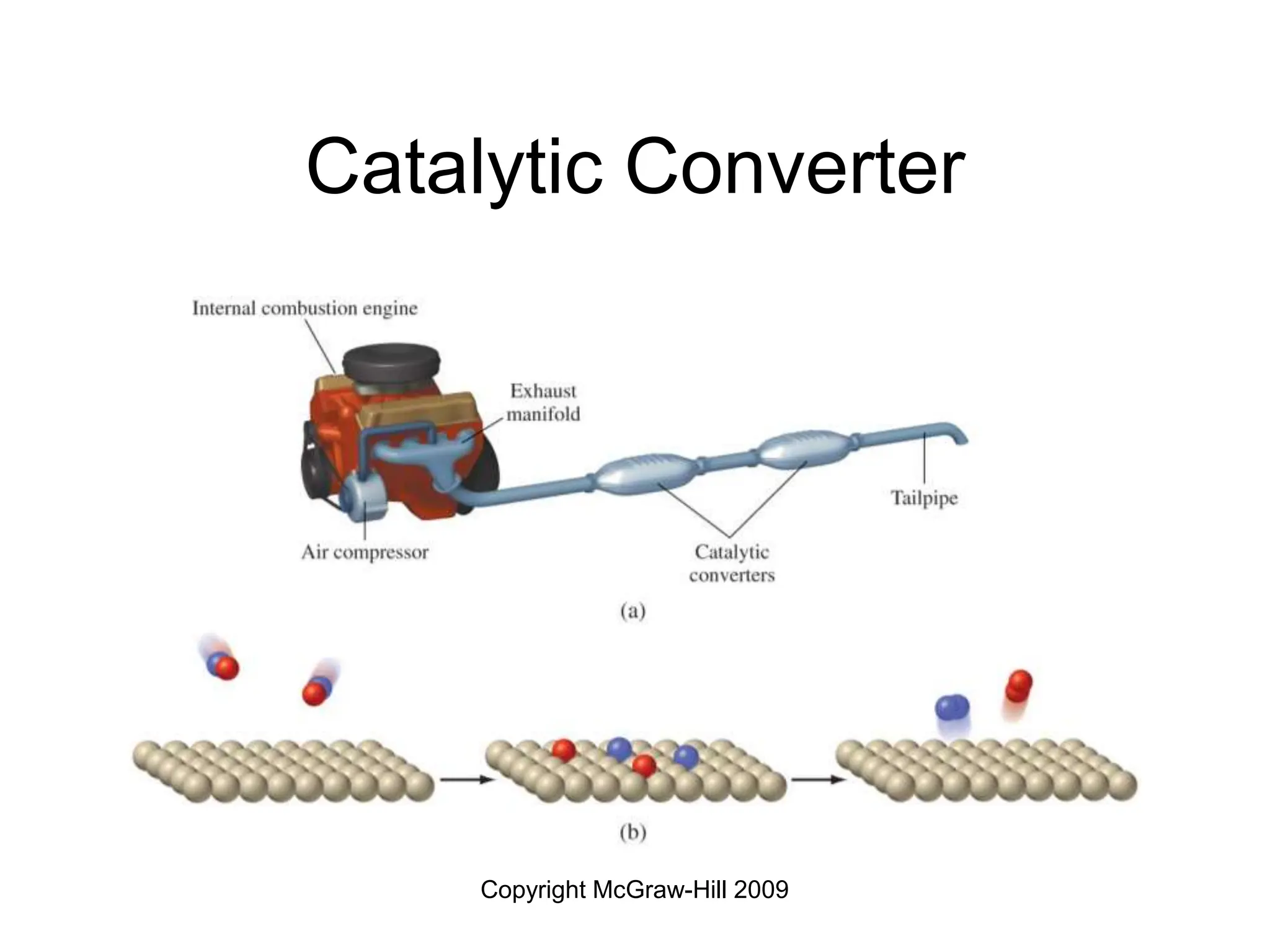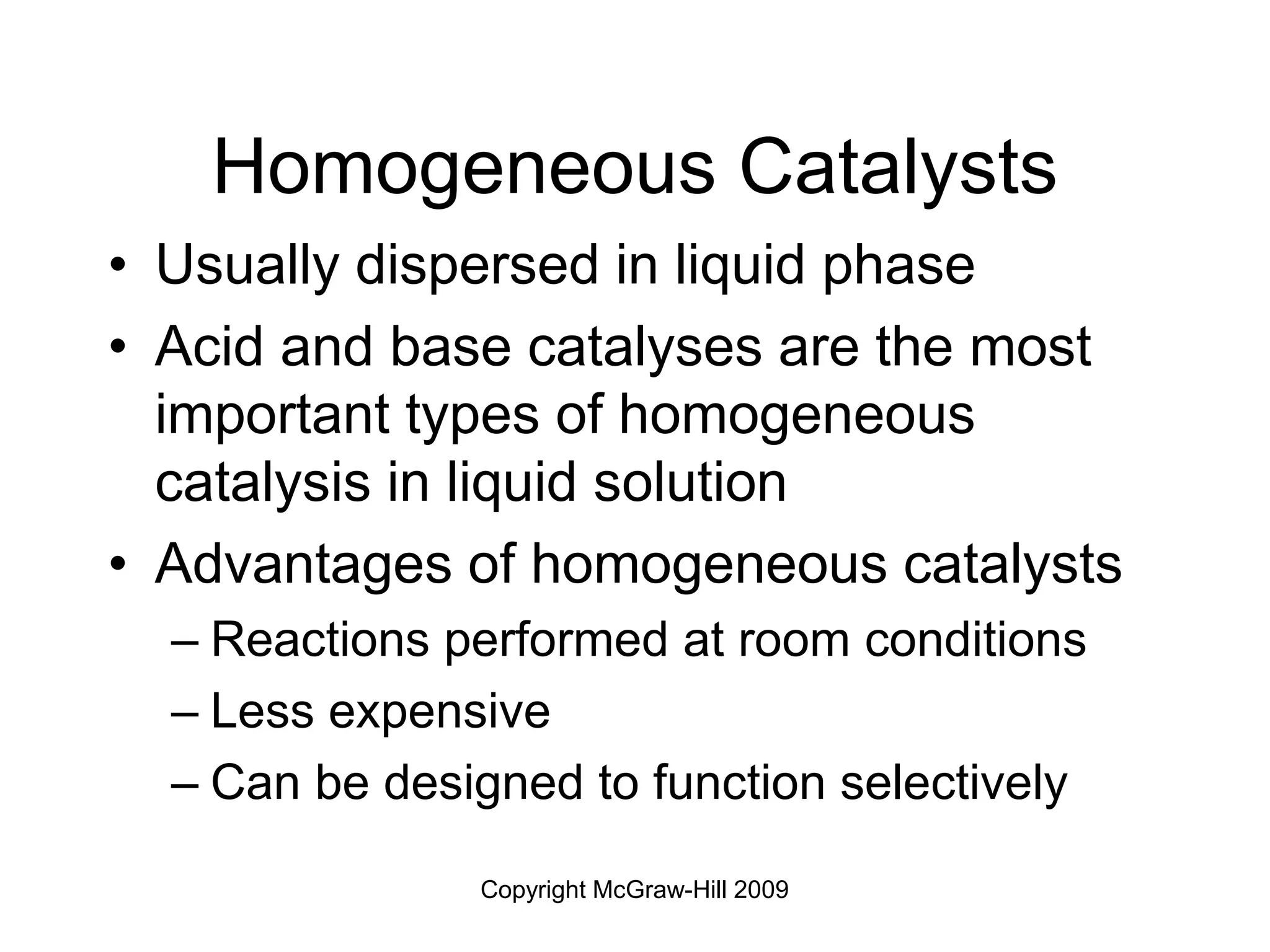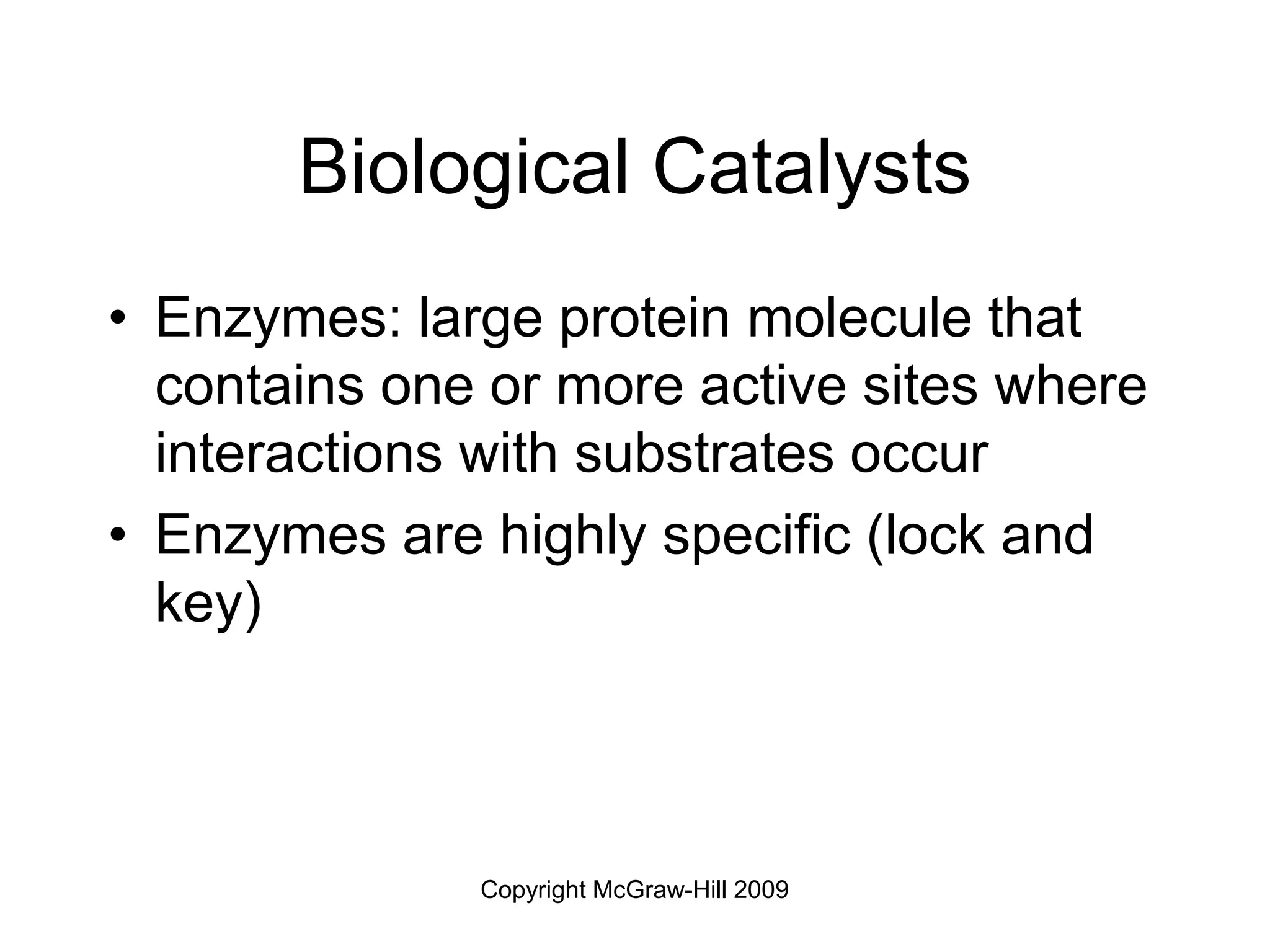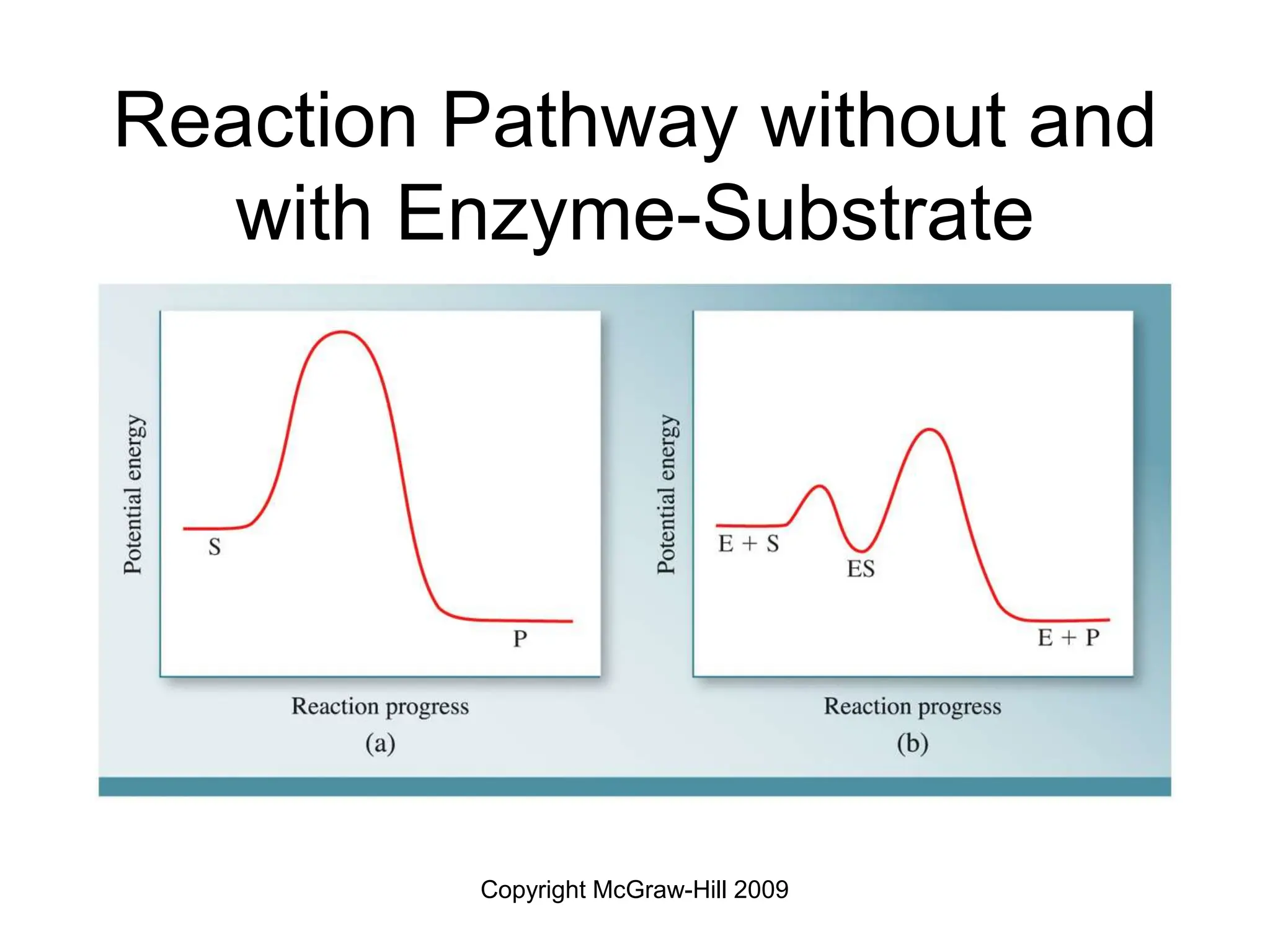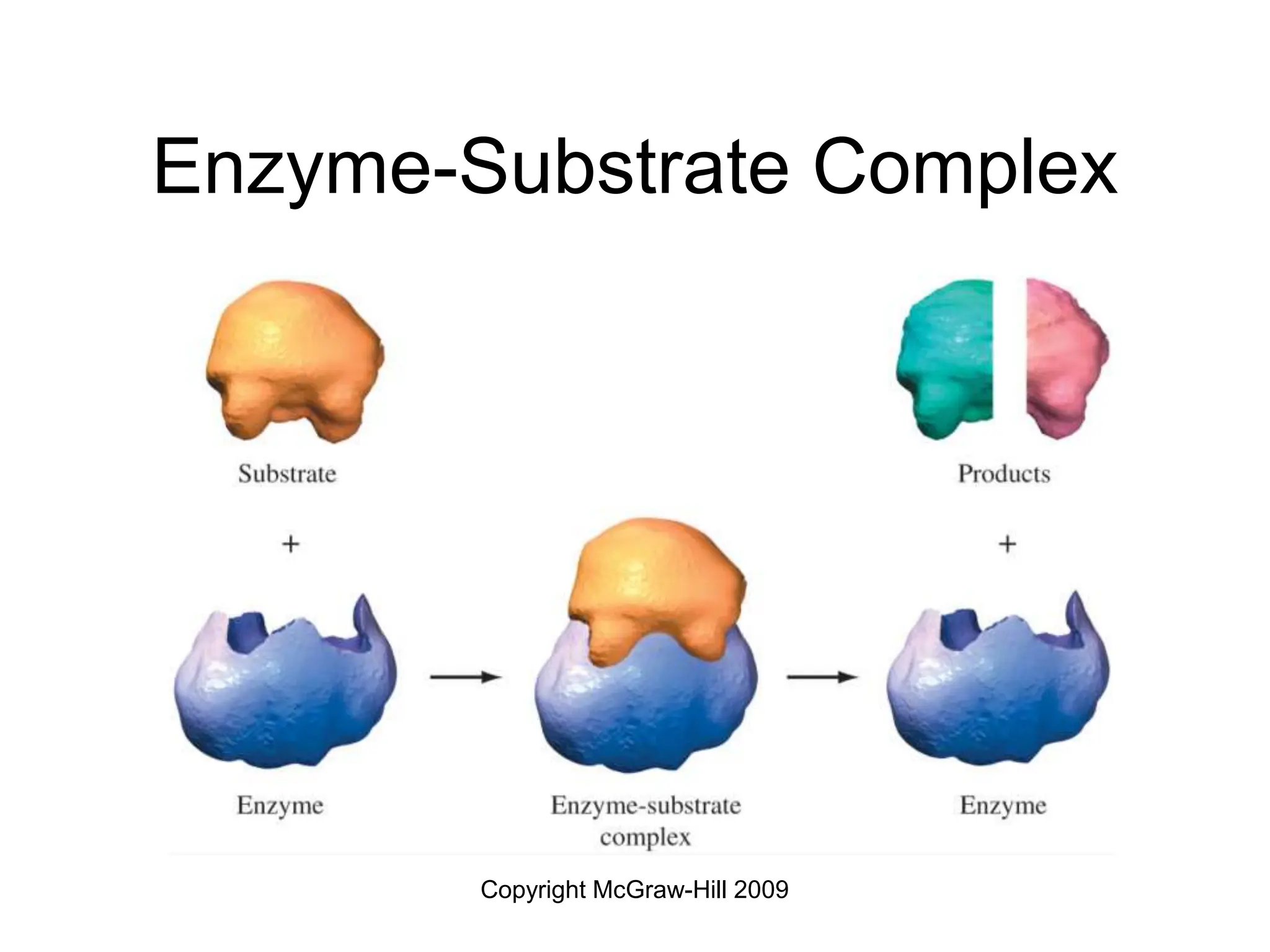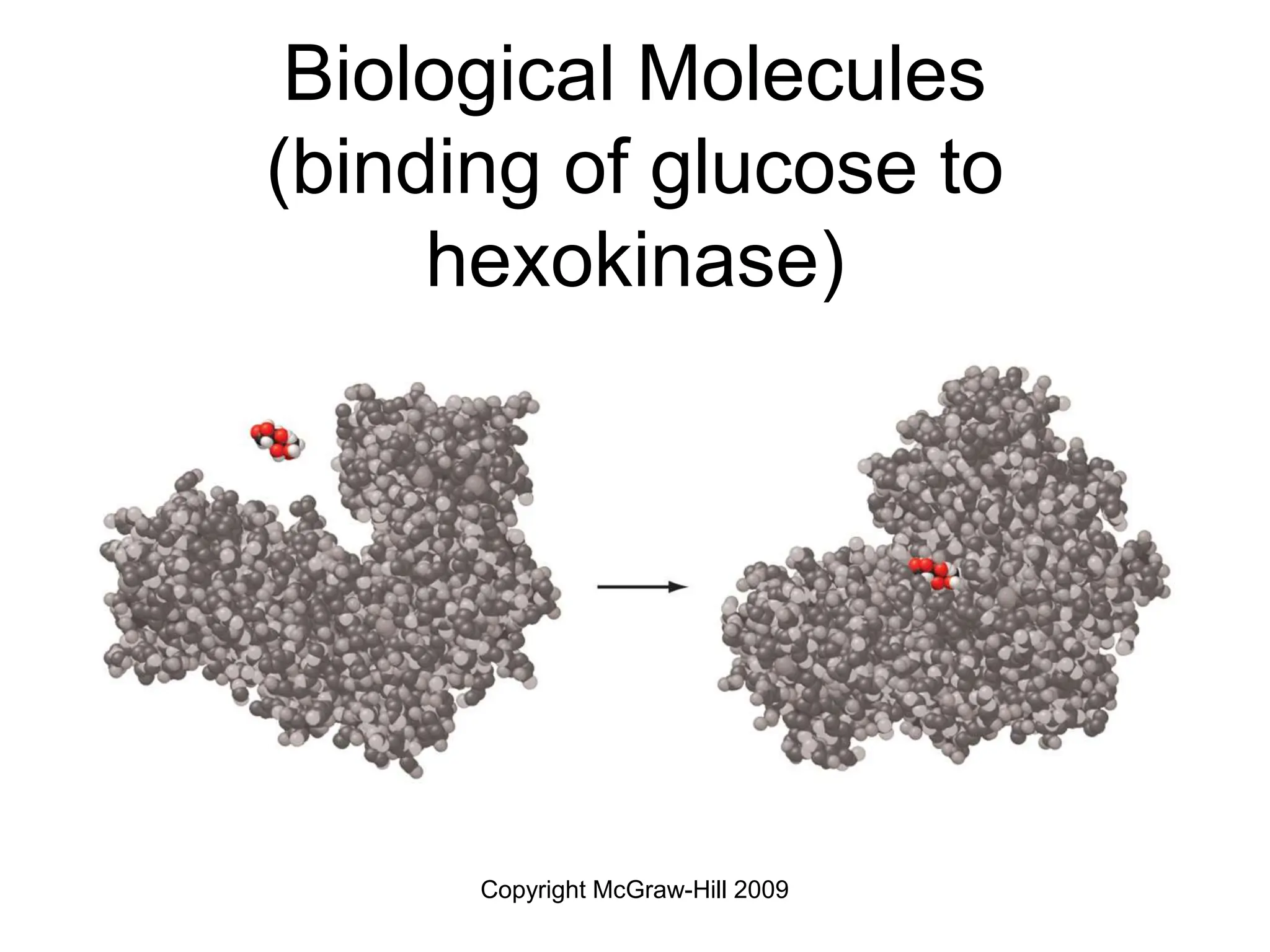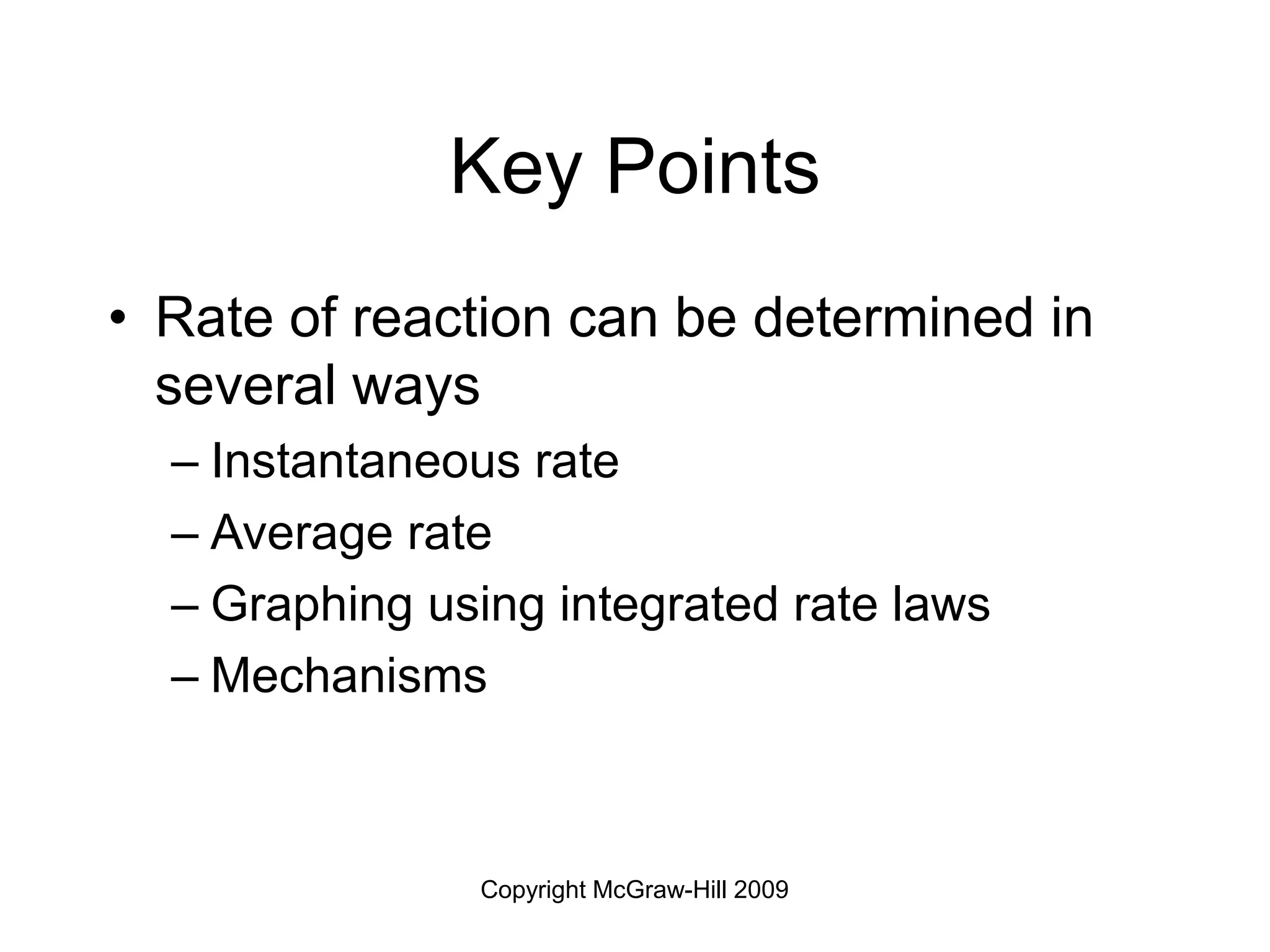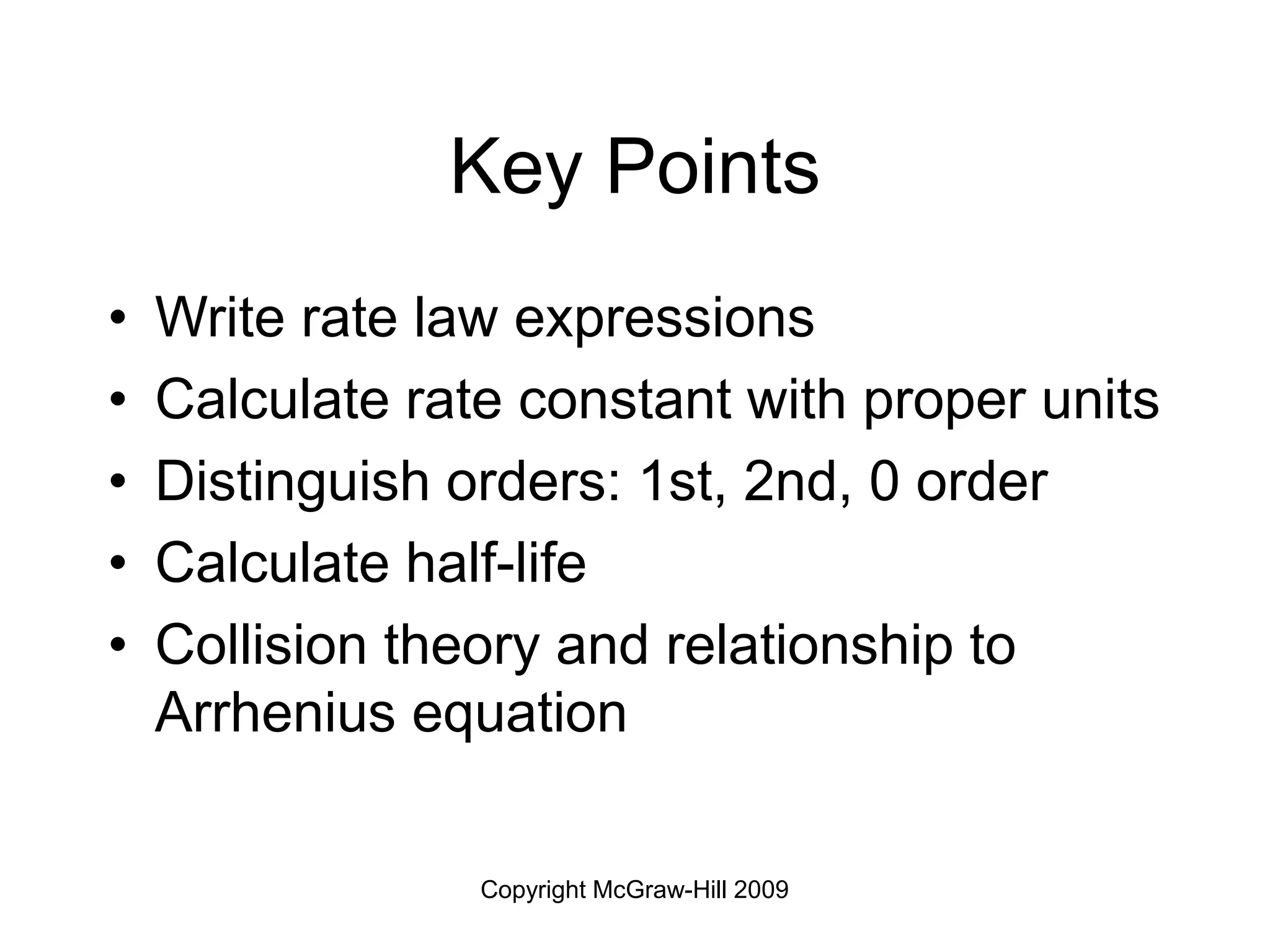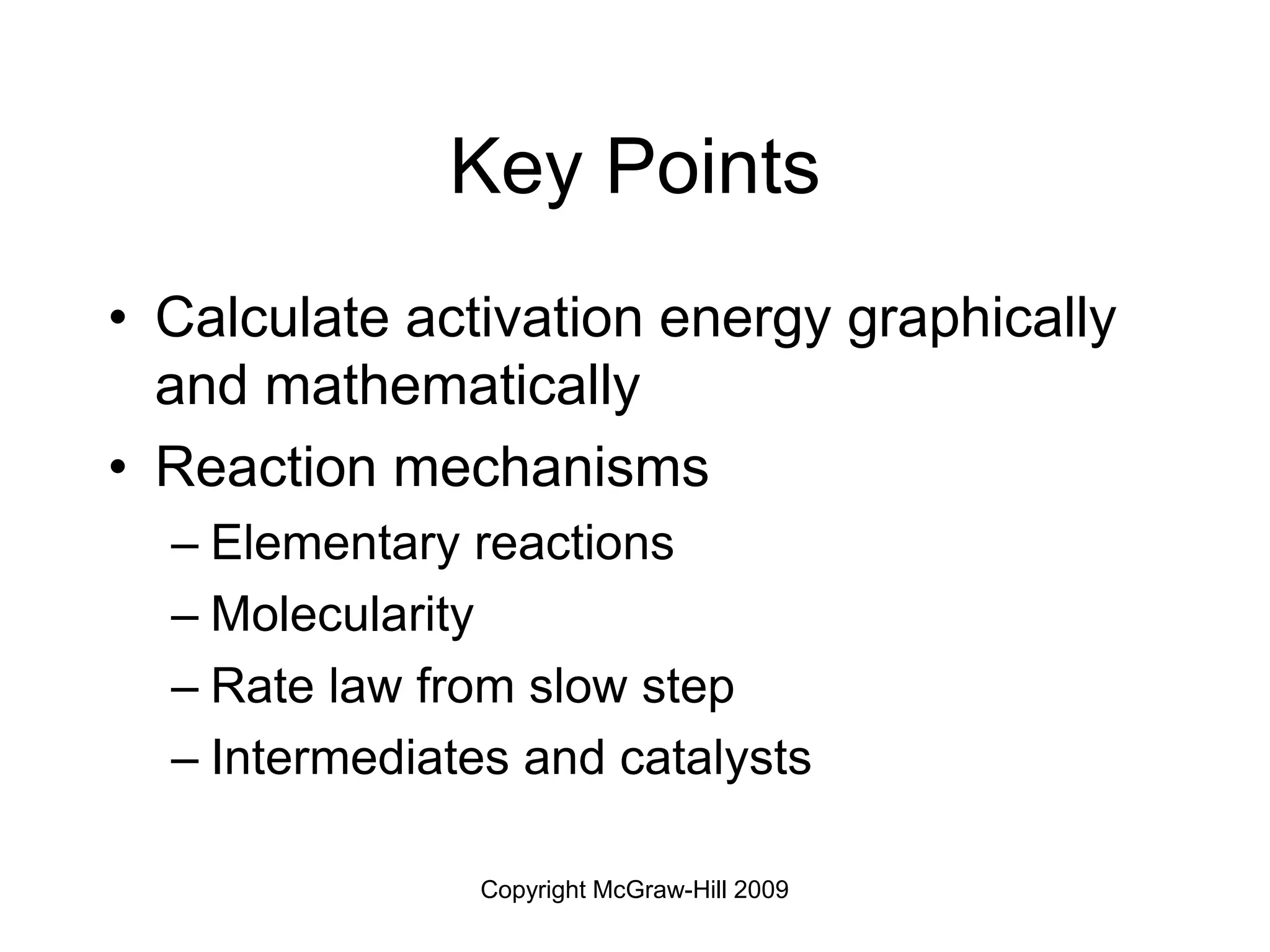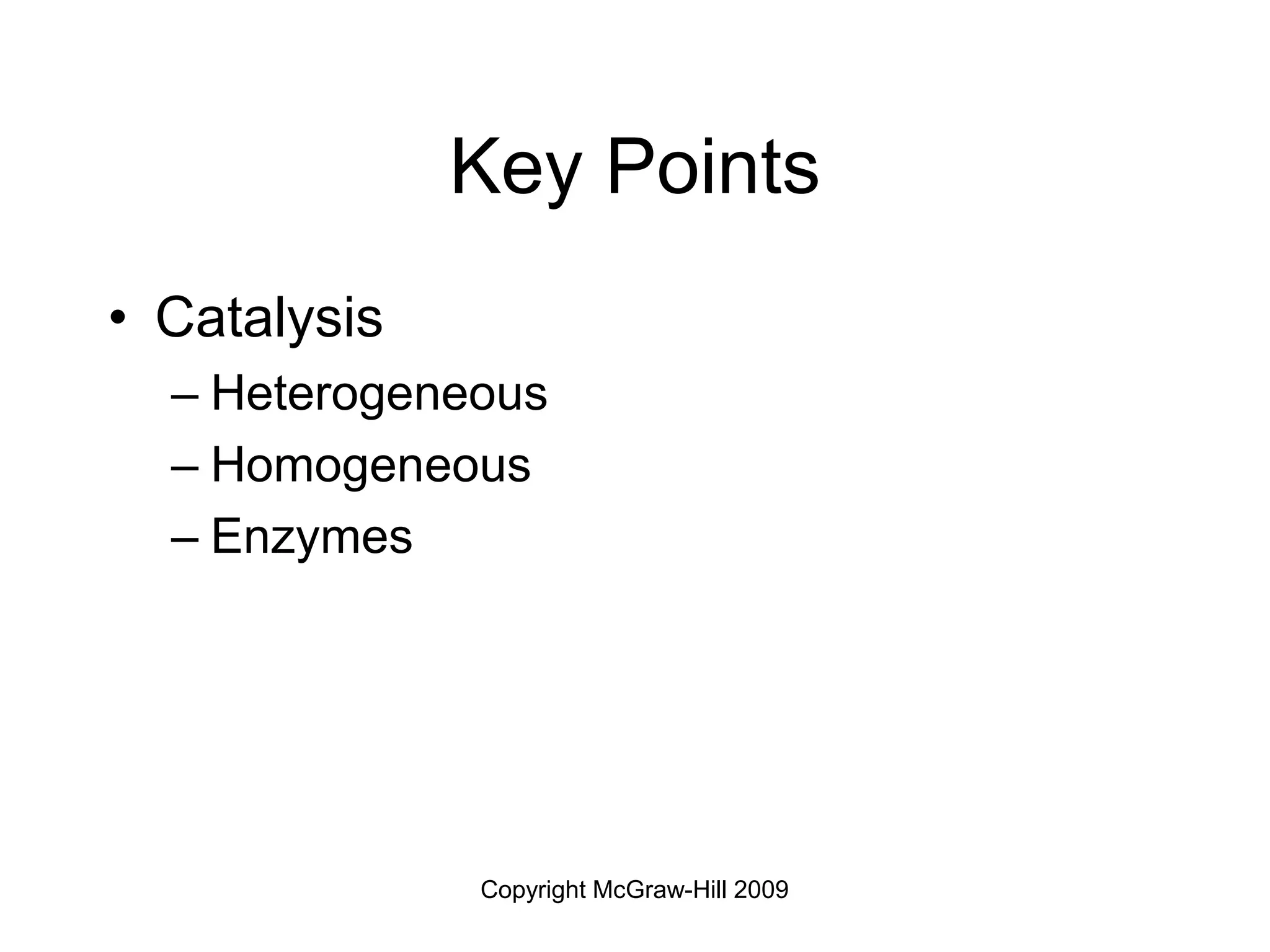This document provides an overview of chemical kinetics and reaction rates. It discusses key topics like:
- Reaction rates can be expressed as the rate of disappearance of reactants or appearance of products over time.
- The average reaction rate and rate constant are defined. Reaction rates depend on concentrations and typically follow rate laws.
- Graphical methods like plotting the natural log of concentration versus time can be used to determine the order of reactions and calculate rate constants from experimental data.
- First-order, second-order, and zero-order reactions have different integrated rate laws and equations to calculate half-lives from the rate constant.


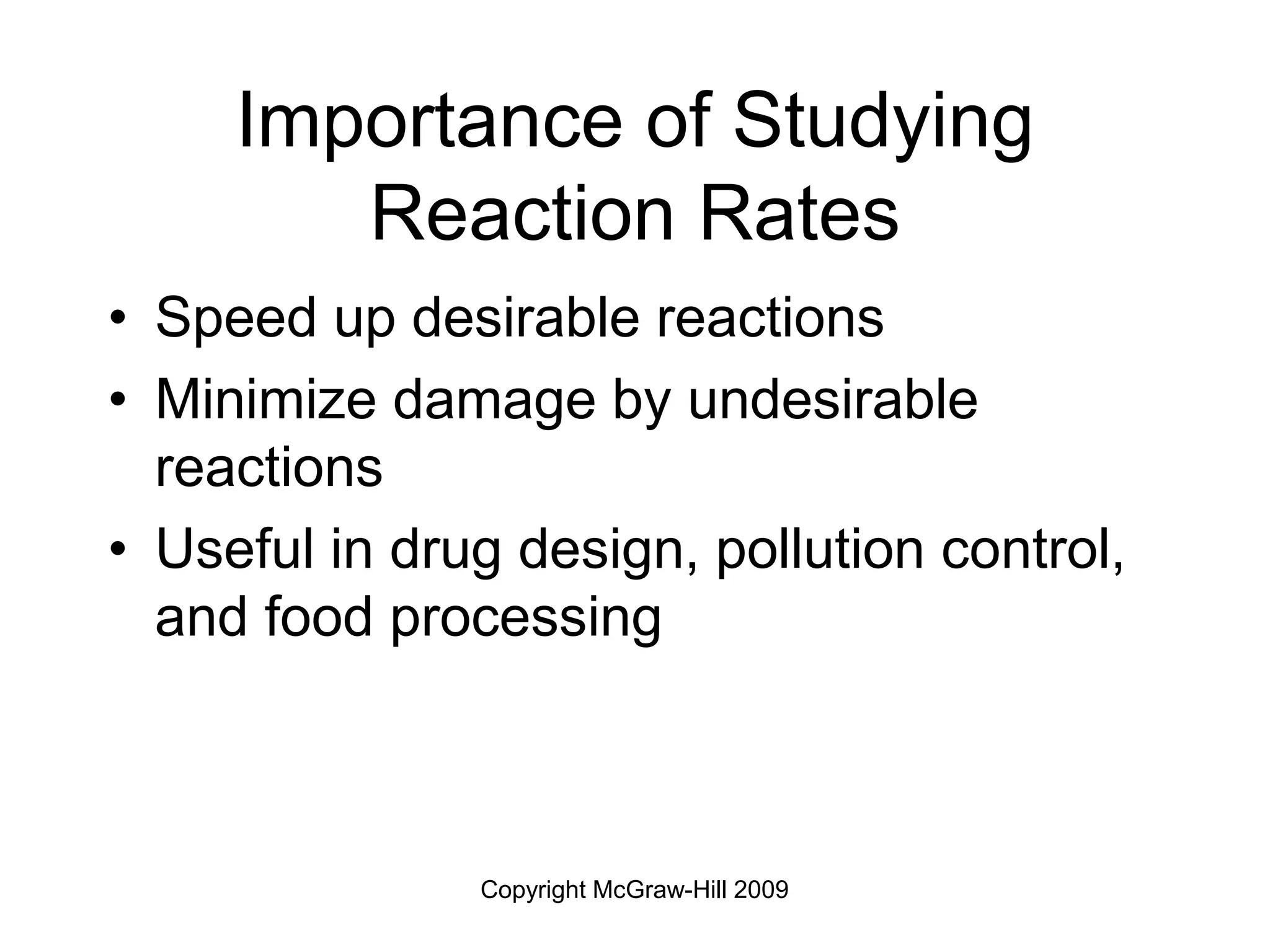
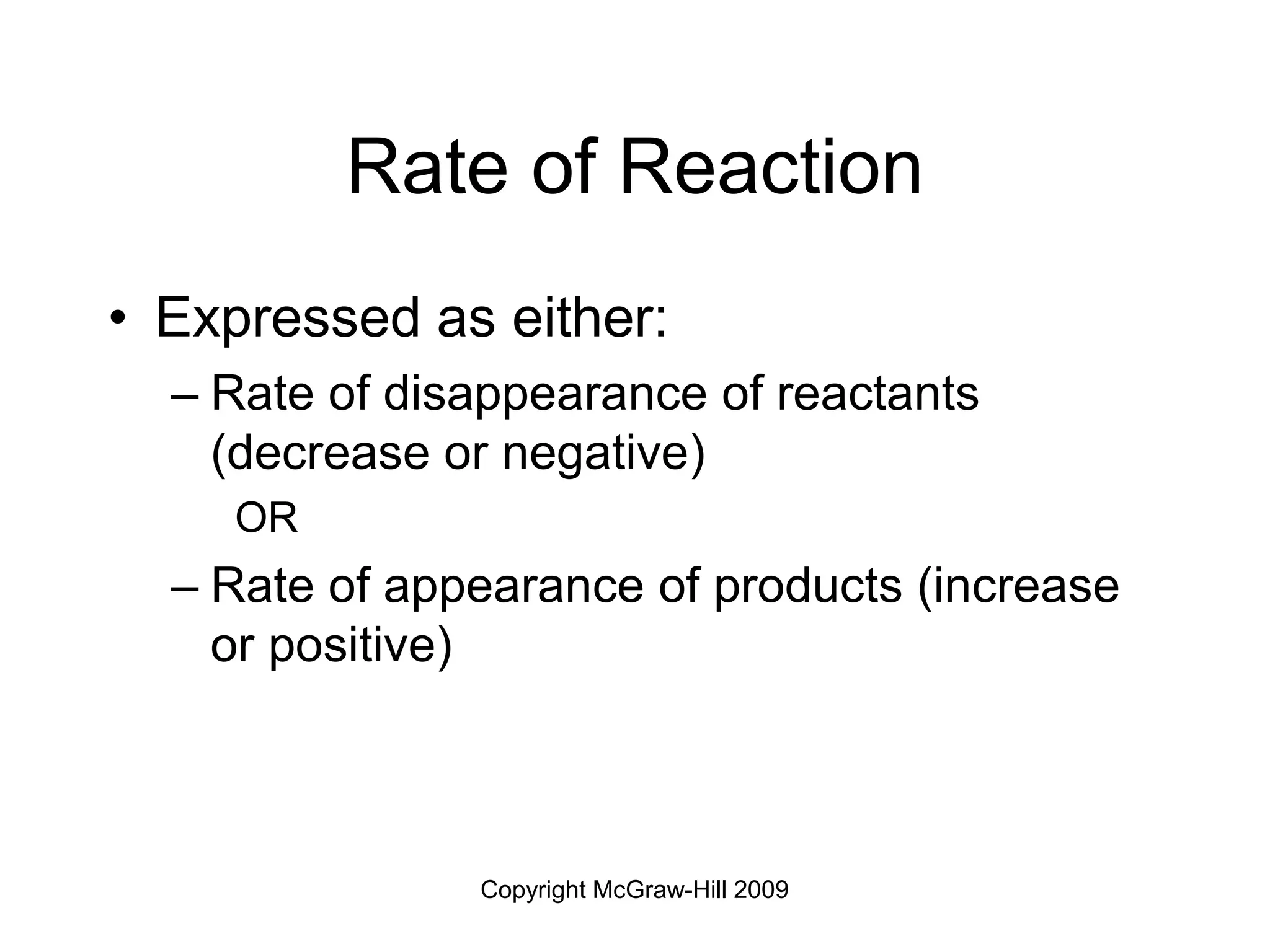
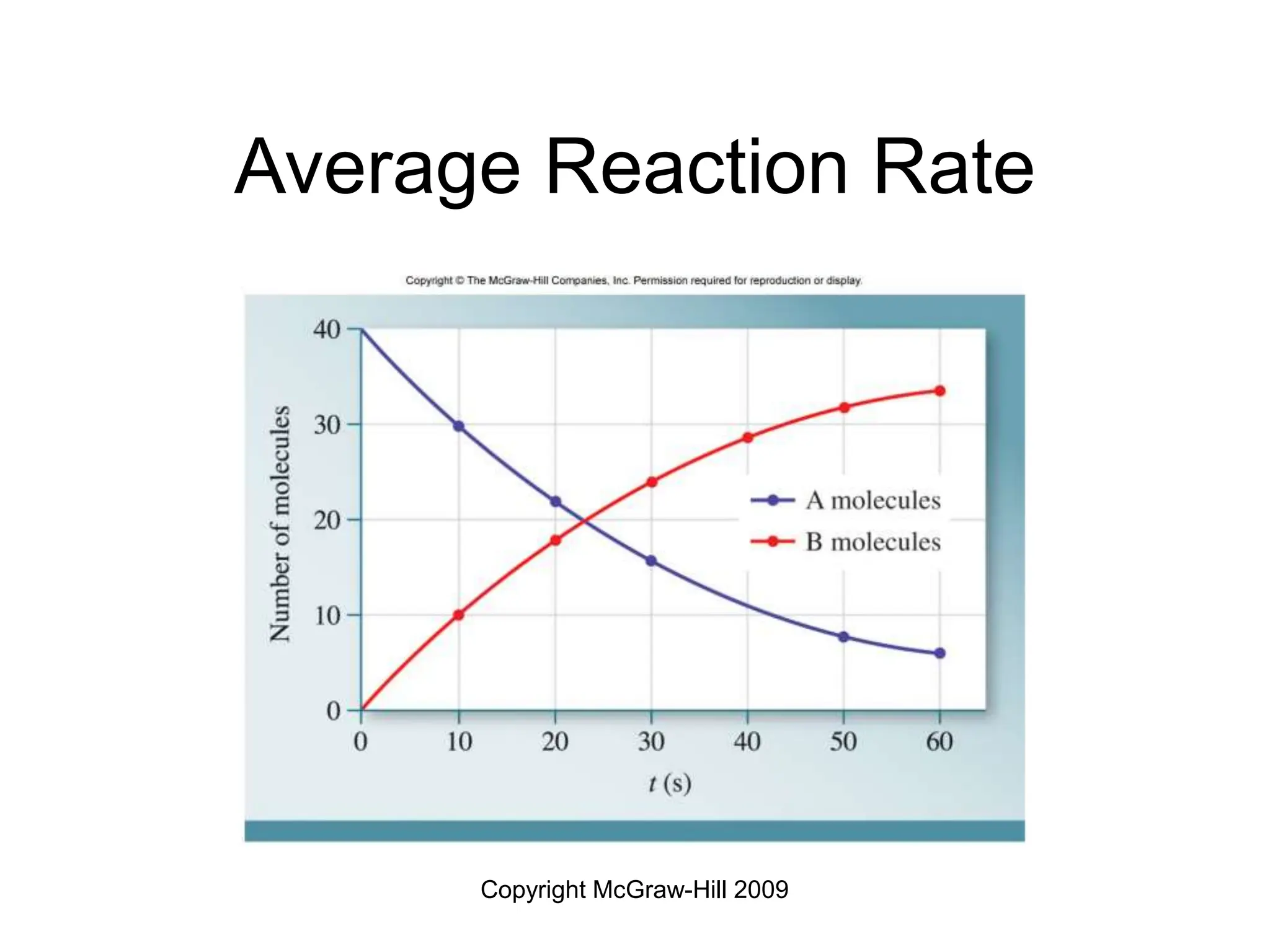
![Copyright McGraw-Hill 2009
Average Reaction Rate
• Equation A B
• rate =
• Why the negative on [A]?
[A] [B]
or
t t
](https://image.slidesharecdn.com/chapter14lecturefinaljrb-240129164745-16be2f1a/75/chapter14_lecture_finalJRB-ppt-6-2048.jpg)
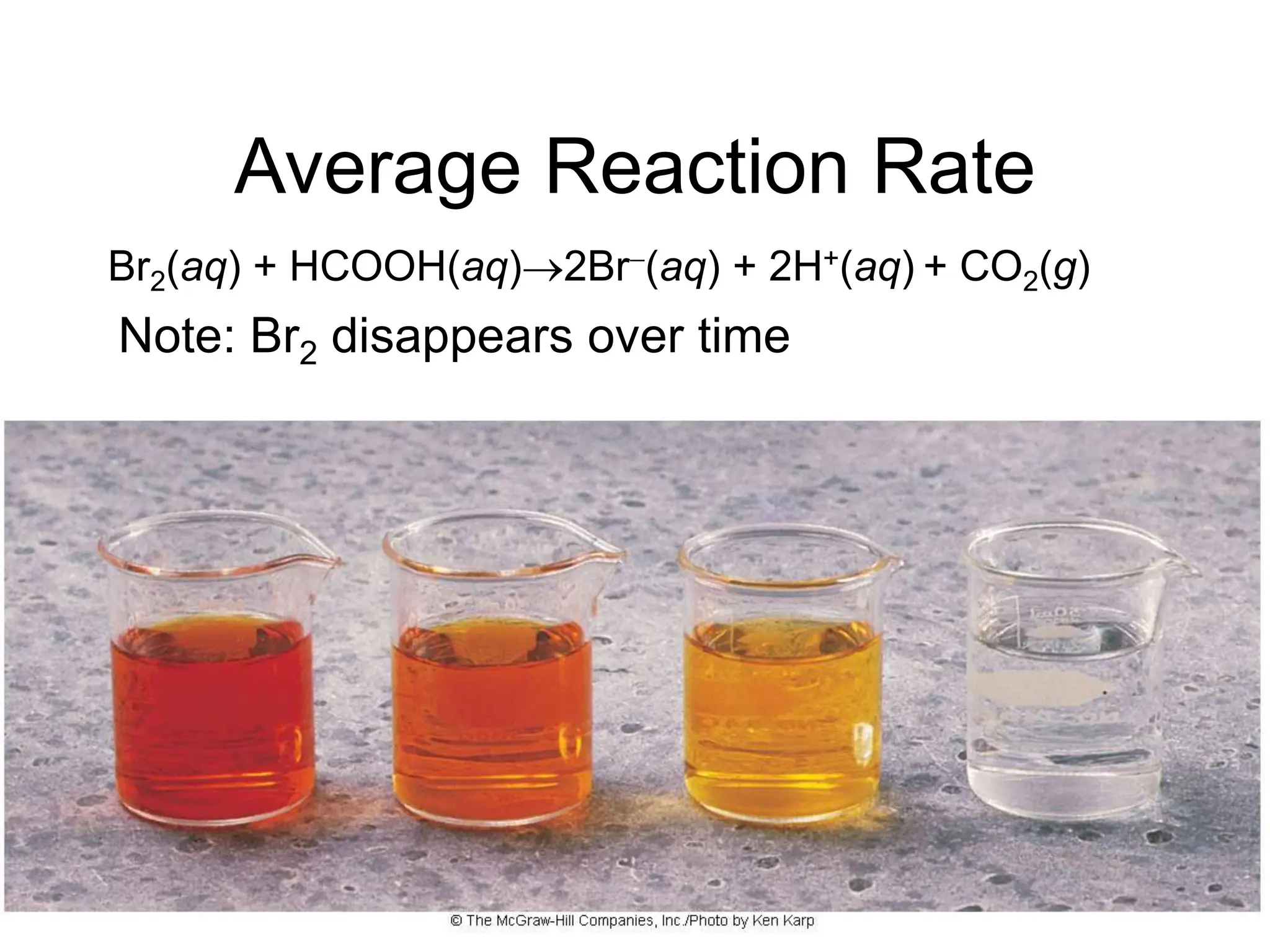
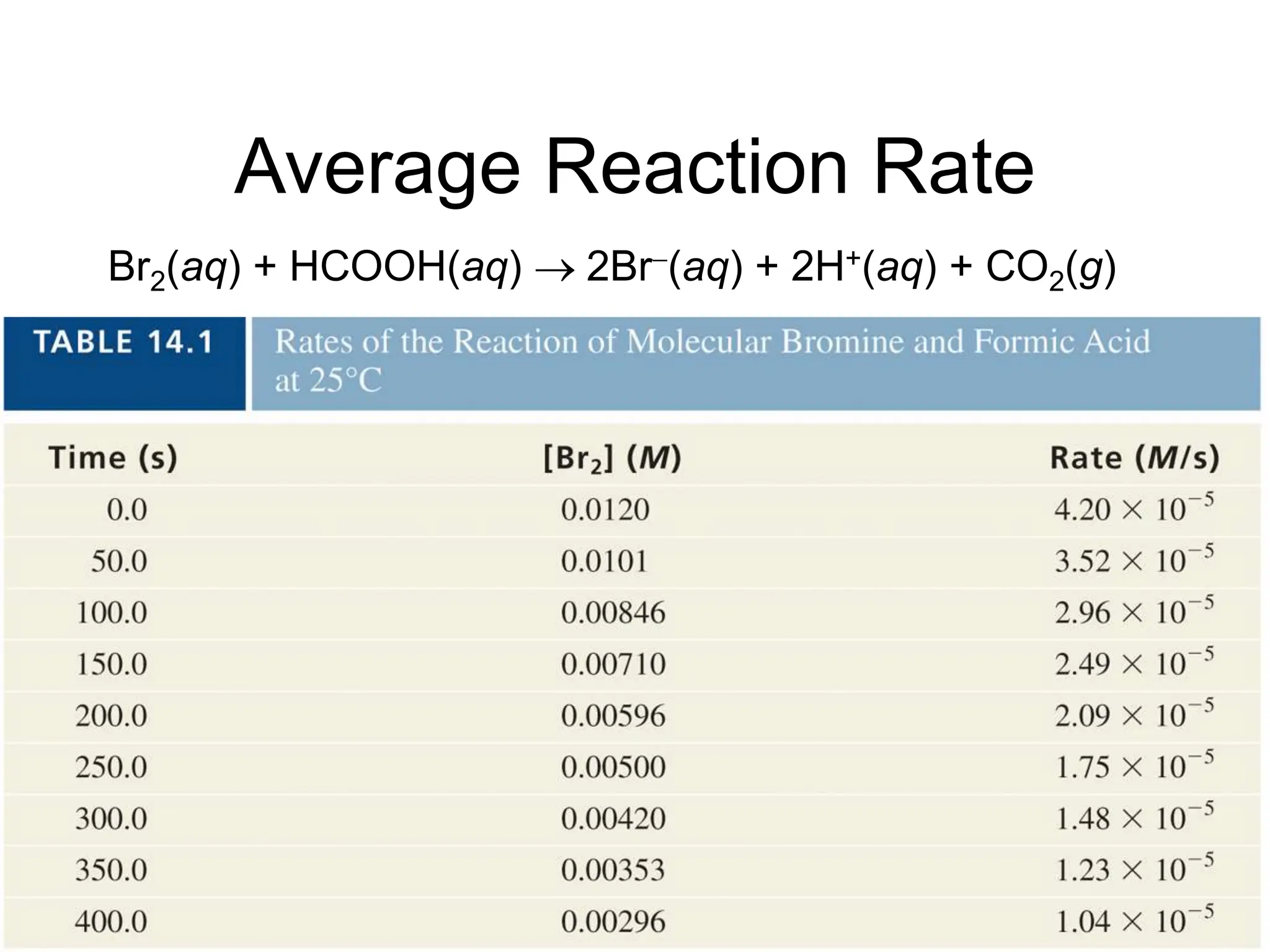
![Copyright McGraw-Hill 2009
Calculate Average Rate
• Avg. rate =
• Avg. rate =
2 2
[Br ] [Br ]
final initial
t t
final initial
= 3.80
0.0101 0.0120
50 0
M M
s s
M / s
](https://image.slidesharecdn.com/chapter14lecturefinaljrb-240129164745-16be2f1a/75/chapter14_lecture_finalJRB-ppt-9-2048.jpg)
![Copyright McGraw-Hill 2009
Average Rate
• Average rate depends on time interval
• Plot of [Br2] vs time = curve
• Plot of Rate vs [Br2] = straight line](https://image.slidesharecdn.com/chapter14lecturefinaljrb-240129164745-16be2f1a/75/chapter14_lecture_finalJRB-ppt-10-2048.jpg)
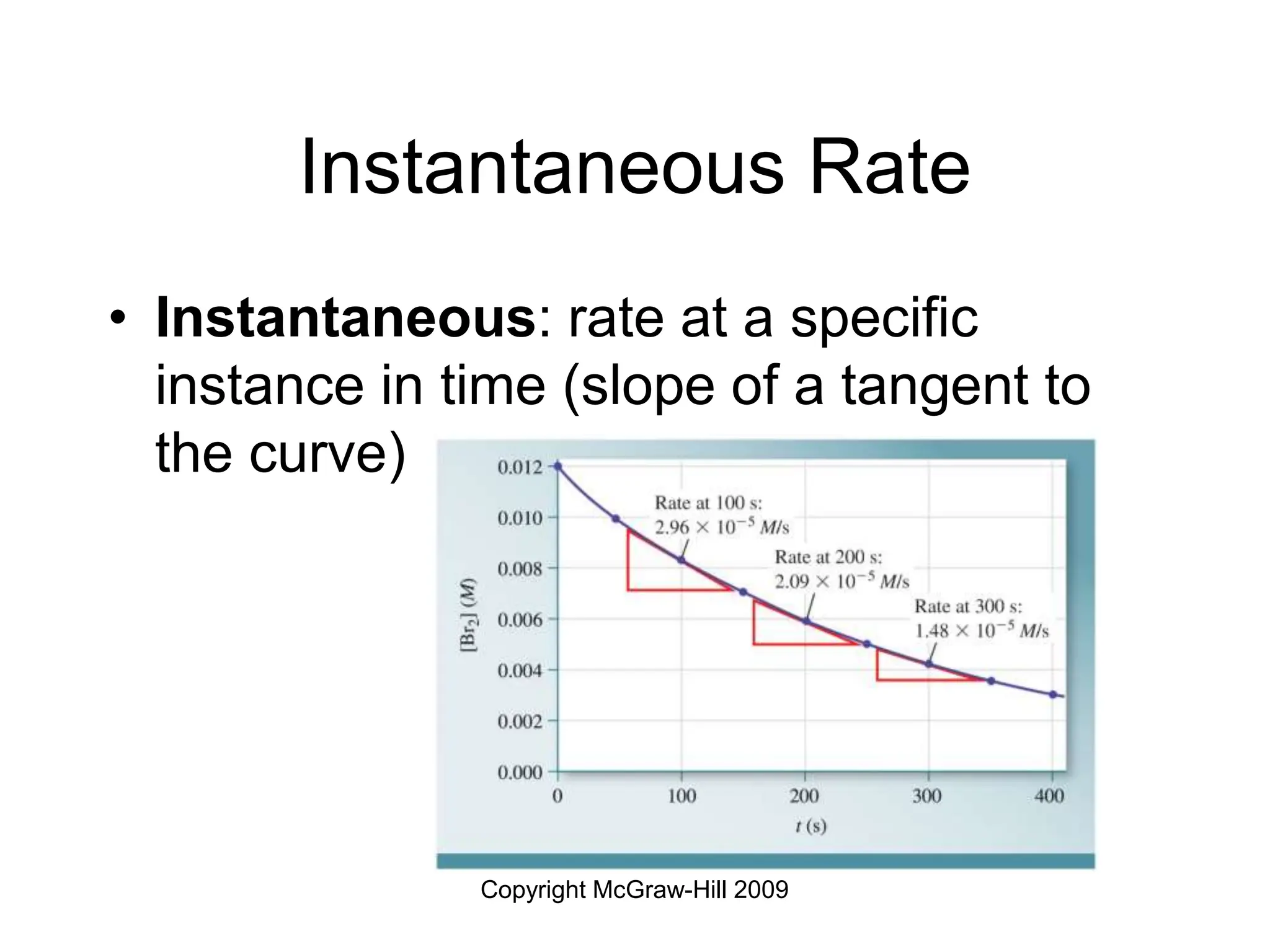
![Copyright McGraw-Hill 2009
Rate Constant
• Using data from Table 14.1 - what can
you conclude?
250
50
Time (s)
1.75 x 105
0.00596
3.52 x 105
0.0101
Rate (M/s)
[Br2]](https://image.slidesharecdn.com/chapter14lecturefinaljrb-240129164745-16be2f1a/75/chapter14_lecture_finalJRB-ppt-12-2048.jpg)
![Copyright McGraw-Hill 2009
Rate Constant
Answer:
• When the [Br2] is halved; the rate is
halved
• Rate is directly proportional to [Br2]
• rate = k [Br2]
• k = proportionality constant and is
constant as long as temp remains
constant](https://image.slidesharecdn.com/chapter14lecturefinaljrb-240129164745-16be2f1a/75/chapter14_lecture_finalJRB-ppt-13-2048.jpg)
![Copyright McGraw-Hill 2009
Rate Constant
• Calculate the value of the rate constant for
any set of data and get basically the same
answer!
• k = rate / [Br2]
5
3.52 x 10 /s 3
3.5x 10 /s
0.0101
M
k
M
](https://image.slidesharecdn.com/chapter14lecturefinaljrb-240129164745-16be2f1a/75/chapter14_lecture_finalJRB-ppt-14-2048.jpg)
![Copyright McGraw-Hill 2009
Stoichiometry and Reaction
Rate
• When stoichiometric ratios are not 1:1
rate of reaction is expressed as follows
General equation:
aA + bB cC + dD
rate =
1 [A] 1 [B] 1 [C] 1 [D]
a t b t c t d t
](https://image.slidesharecdn.com/chapter14lecturefinaljrb-240129164745-16be2f1a/75/chapter14_lecture_finalJRB-ppt-15-2048.jpg)

![Copyright McGraw-Hill 2009
Stoichiometry and Reaction
Rate
4PH3(g) P4(g) + 6H2(g)
If molecular hydrogen is formed at a rate of
0.168 M/s, at what rate is P4 being
produced?
3 4 2
1 [PH ] 1 [P ] 1 [H ]
4 1 6
t t t
](https://image.slidesharecdn.com/chapter14lecturefinaljrb-240129164745-16be2f1a/75/chapter14_lecture_finalJRB-ppt-17-2048.jpg)
![Copyright McGraw-Hill 2009
Stoichiometry and Reaction
Rate
4PH3(g) P4(g) + 6H2(g)
2
1 [H ] 1
(0.168 /s) 0.028 /s
6 6
M M
t
4
1 [P ]
0.028 /s
1
M
t
](https://image.slidesharecdn.com/chapter14lecturefinaljrb-240129164745-16be2f1a/75/chapter14_lecture_finalJRB-ppt-18-2048.jpg)
![Copyright McGraw-Hill 2009
14.2 Dependence of Reaction
Rate on Reactant
Concentration
• Rate law expression
For the general equation:
aA + bB cC + dD
rate law = k[A]x[B]y
k = proportionality constant
x and y = the order of the reaction with
respect to each reactant](https://image.slidesharecdn.com/chapter14lecturefinaljrb-240129164745-16be2f1a/75/chapter14_lecture_finalJRB-ppt-19-2048.jpg)
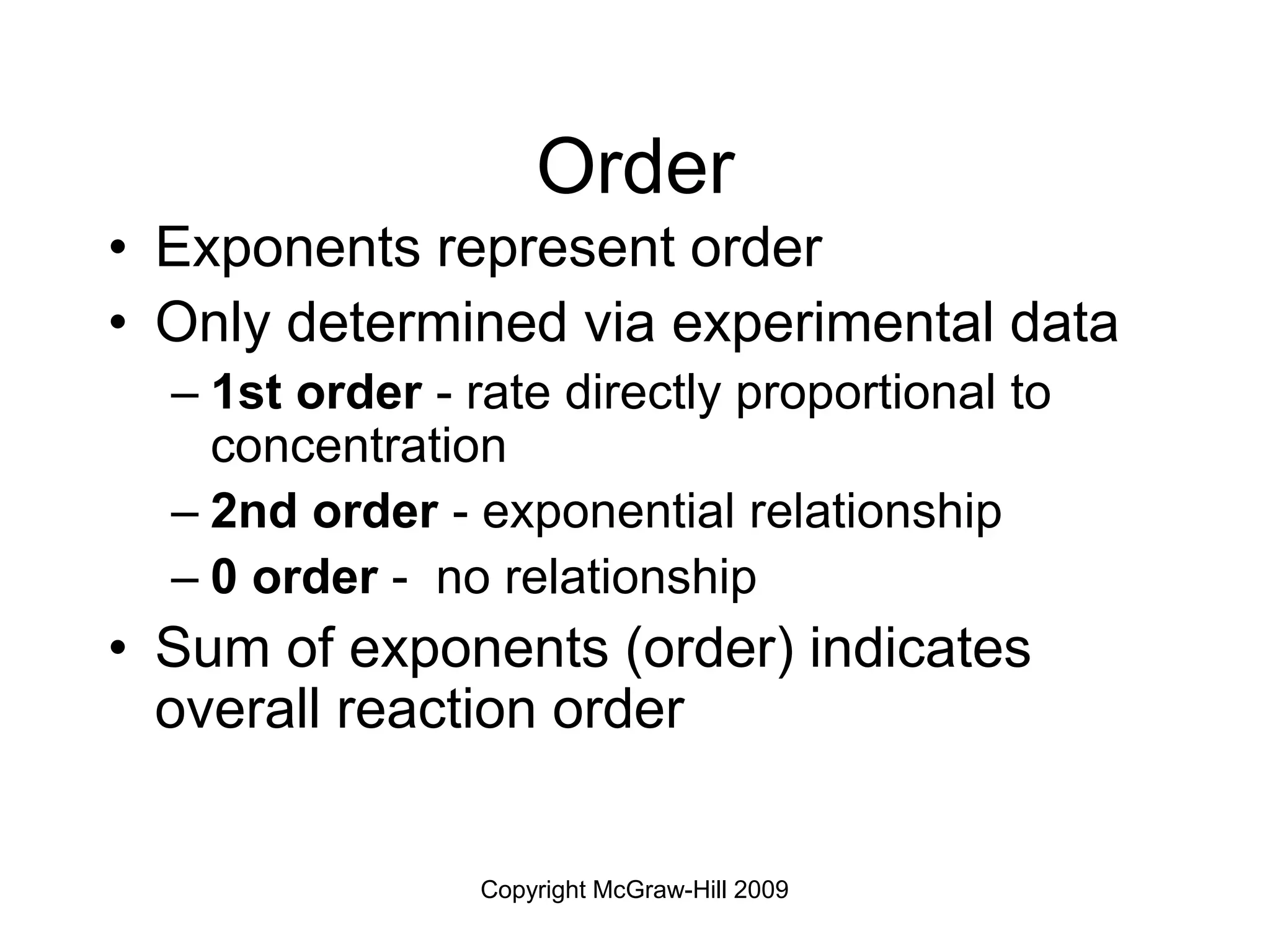
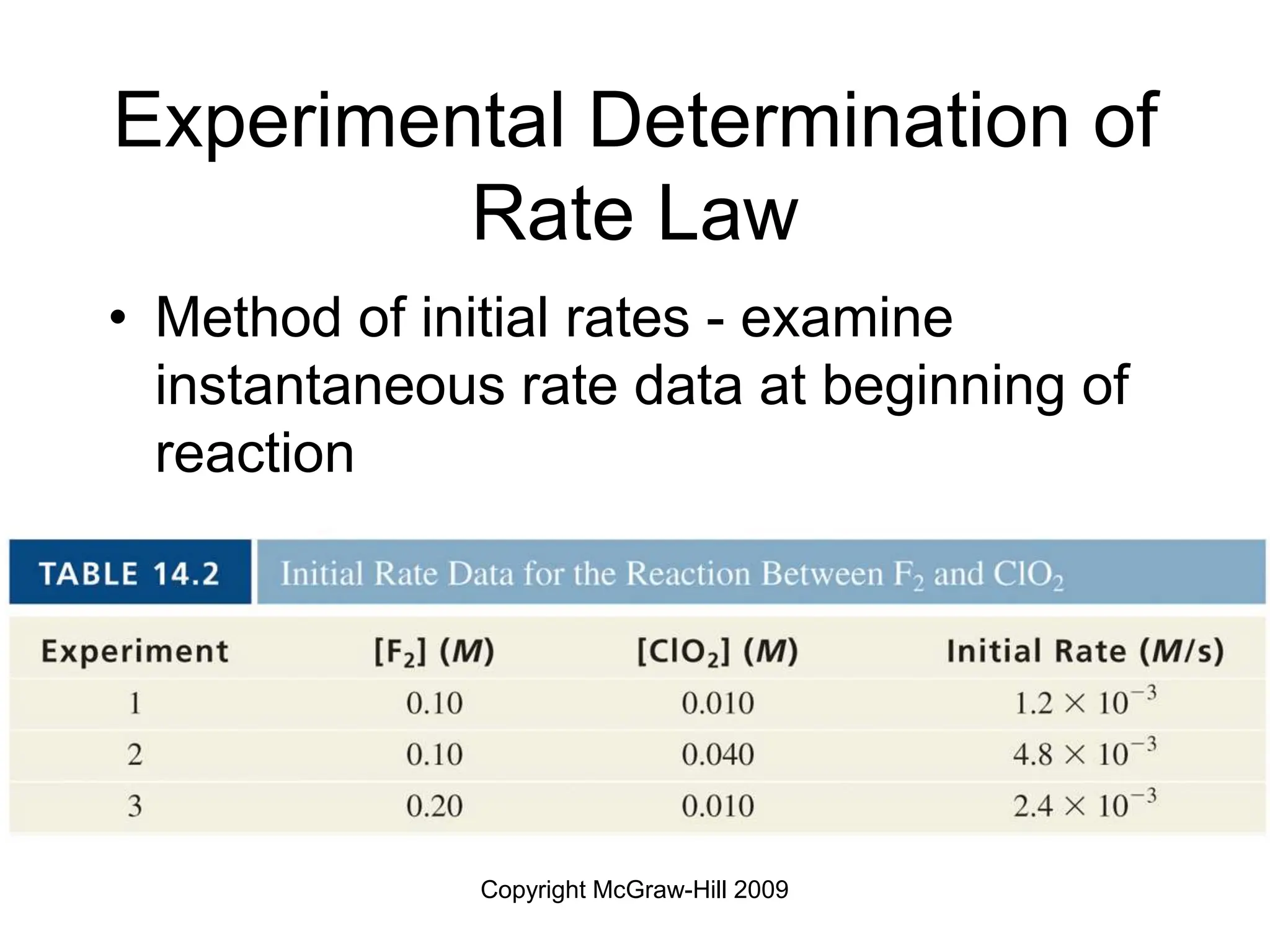
![Copyright McGraw-Hill 2009
rate = k[F2]x [ClO2]y
Find order (exponents) by comparing data
Exp. 1 and 3: [ClO2] is held constant
1st order with respect to [F2] (rate and M directly related)
2
2
[F ]
0.20
3 2
[F ] 0.10
1
M
M
[rate] 3
2.4 10 /s
3 2
3
[rate] 1.2 10 /s
1
M
M
](https://image.slidesharecdn.com/chapter14lecturefinaljrb-240129164745-16be2f1a/75/chapter14_lecture_finalJRB-ppt-22-2048.jpg)
![Copyright McGraw-Hill 2009
rate = k[F2]1[ClO2]y
Find order (exponents) by comparing data
Exp. 1 and 2: [F2] is held constant
2
2
[ClO ]
0.040
2 4
[ClO ] 0.010
1
M
M
1st order with respect to [ClO2] (rate and M directly related)
[rate] 3
4.8 10 /s
2 4
3
[rate] 1.2 10 /s
1
M
M
](https://image.slidesharecdn.com/chapter14lecturefinaljrb-240129164745-16be2f1a/75/chapter14_lecture_finalJRB-ppt-23-2048.jpg)
![Copyright McGraw-Hill 2009
rate = k[F2]1[ClO2]1 overall order = 2
Find k (use any set of data)
4
[rate] 2.1 10 /s 2 1
9.3 s
2 2
[A] [B] (0.10 ) (0.015 )
M
k M
M M
](https://image.slidesharecdn.com/chapter14lecturefinaljrb-240129164745-16be2f1a/75/chapter14_lecture_finalJRB-ppt-24-2048.jpg)
![Copyright McGraw-Hill 2009
Determining Rate Law
8.4 x 102
0.030
0.10
3
4.2 x 104
0.015
0.20
2
2.1 x 104
0.015
0.10
1
Initial
Rate
(M/s)
[B] (M)
[A] (M)
Exp.](https://image.slidesharecdn.com/chapter14lecturefinaljrb-240129164745-16be2f1a/75/chapter14_lecture_finalJRB-ppt-25-2048.jpg)
![Copyright McGraw-Hill 2009
What is Different?
• In experiment 1 and 2; [B] is constant;
[A] doubles and rate doubles - the
reaction is 1st order with respect to [A]
• In experiment 1 and 3; [A] is constant;
[B] doubles but the rate quadruples!
This means that the reaction is 2nd
order with respect to [B]](https://image.slidesharecdn.com/chapter14lecturefinaljrb-240129164745-16be2f1a/75/chapter14_lecture_finalJRB-ppt-26-2048.jpg)
![Copyright McGraw-Hill 2009
Calculate the Rate Constant
• Rate = k[A] [B]2
• The rxn is 1st order w/ respect to [A]
• The rxn is 2nd order w/ respect to [B]
• The rxn is 3rd order overall (1 + 2)
4
[rate] 2.1 10 /s 2 1
9.3 s
2 2
[A] [B] (0.10 M) (0.015 )
M
k M
M
](https://image.slidesharecdn.com/chapter14lecturefinaljrb-240129164745-16be2f1a/75/chapter14_lecture_finalJRB-ppt-27-2048.jpg)
![Copyright McGraw-Hill 2009
14.3 Dependence of Reactant
Concentration on Time
• First-Order reactions may be
expressed in several ways
• Example: A products
rate = k[A]
[ ]
rate
t
A](https://image.slidesharecdn.com/chapter14lecturefinaljrb-240129164745-16be2f1a/75/chapter14_lecture_finalJRB-ppt-28-2048.jpg)
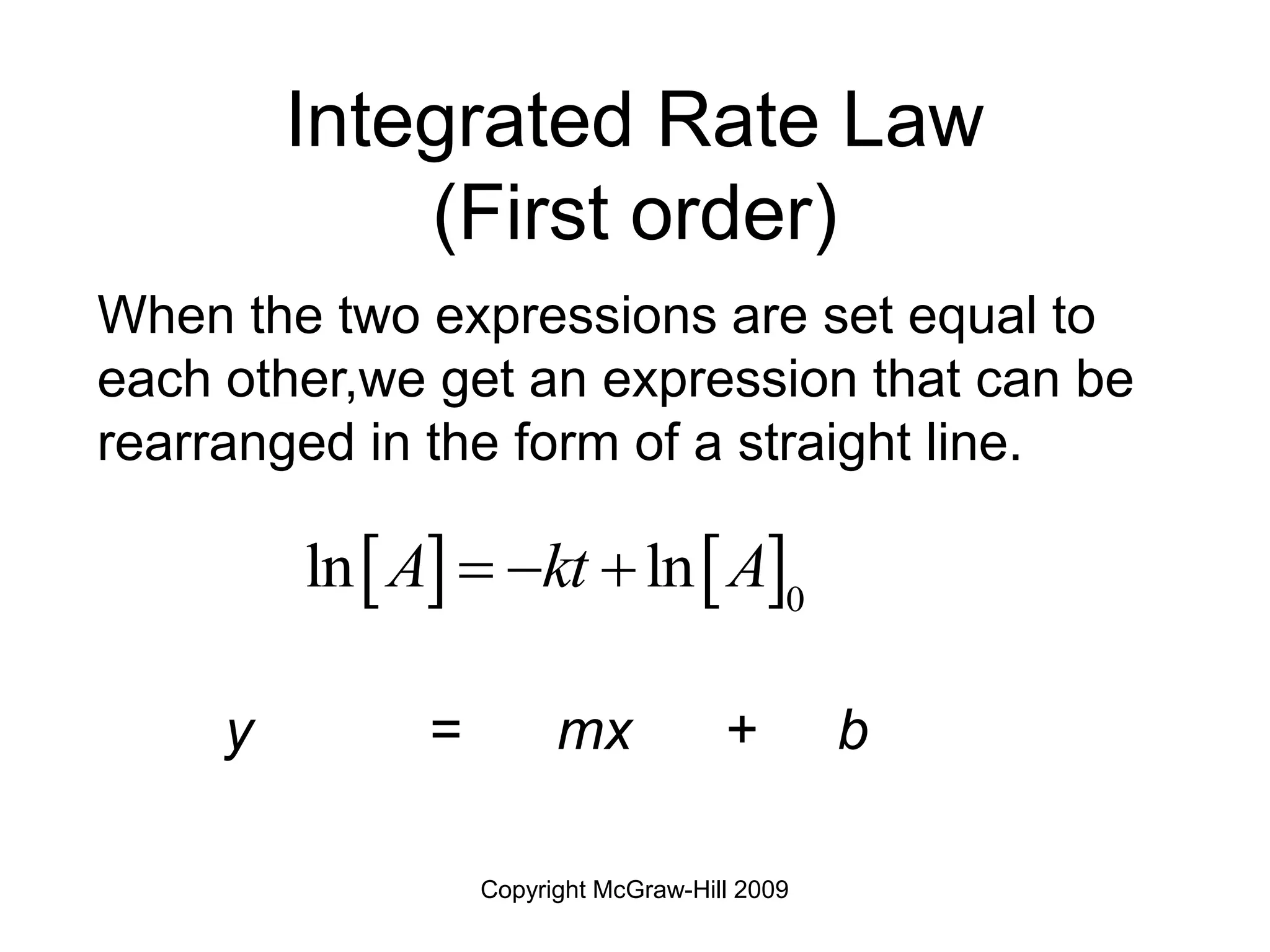

![Copyright McGraw-Hill 2009
Integrated Rate Law
(First order)
• For a 1st order reaction, a plot of ln [A]
vs time yields a straight line
• The slope = k (the rate constant)](https://image.slidesharecdn.com/chapter14lecturefinaljrb-240129164745-16be2f1a/75/chapter14_lecture_finalJRB-ppt-31-2048.jpg)
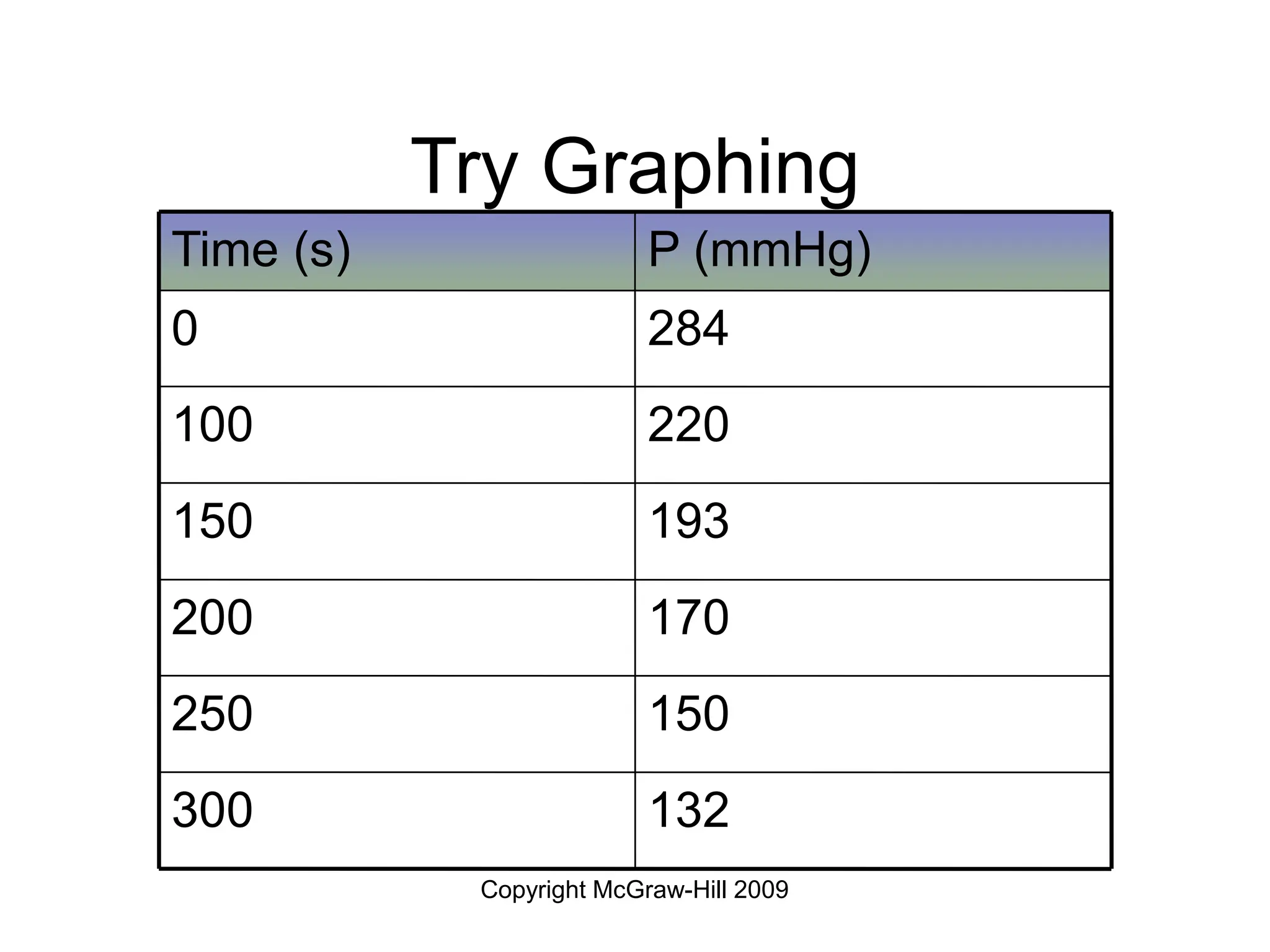
![Copyright McGraw-Hill 2009
Graphing
• Plot ln [Pressure] on y-axis and time on
x-axis
• If the plot is a straight line, then the
integrated rate law equation can be
used to find the rate constant, k, or the
slope of the line can be calculated for
the rate constant.](https://image.slidesharecdn.com/chapter14lecturefinaljrb-240129164745-16be2f1a/75/chapter14_lecture_finalJRB-ppt-33-2048.jpg)
![Copyright McGraw-Hill 2009
Integrated Rate Law
• The rate constant for the reaction
2A B is 7.5 x 103 s1 at 110C. The
reaction is 1st order in A. How long (in
seconds) will it take for [A] to decrease
from 1.25 M to 0.71 M?](https://image.slidesharecdn.com/chapter14lecturefinaljrb-240129164745-16be2f1a/75/chapter14_lecture_finalJRB-ppt-34-2048.jpg)
![Copyright McGraw-Hill 2009
• Another form of the integrated rate law
[A]
ln
[A]
0
t kt
(0.71 M) 3 1
ln 7.5 10 s ( )
(1.25 M)
75 s
t
t
](https://image.slidesharecdn.com/chapter14lecturefinaljrb-240129164745-16be2f1a/75/chapter14_lecture_finalJRB-ppt-35-2048.jpg)
![Copyright McGraw-Hill 2009
Your Turn!
• Consider the same first order reaction
2A B, for which k = 7.5 x 103 s1 at
110C. With a starting concentration of
[A] = 2.25 M, what will [A] be after 2.0
minutes?](https://image.slidesharecdn.com/chapter14lecturefinaljrb-240129164745-16be2f1a/75/chapter14_lecture_finalJRB-ppt-36-2048.jpg)
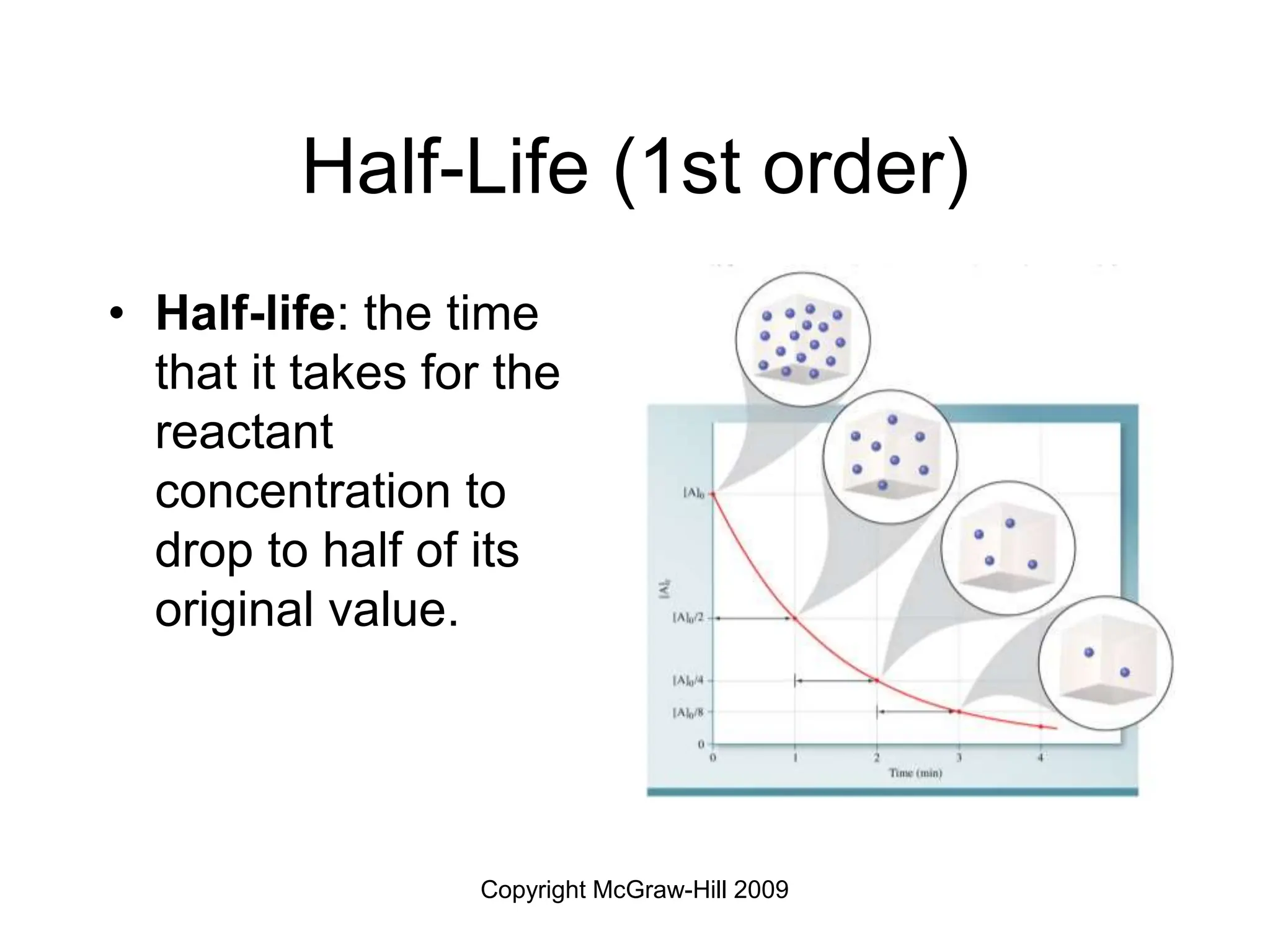
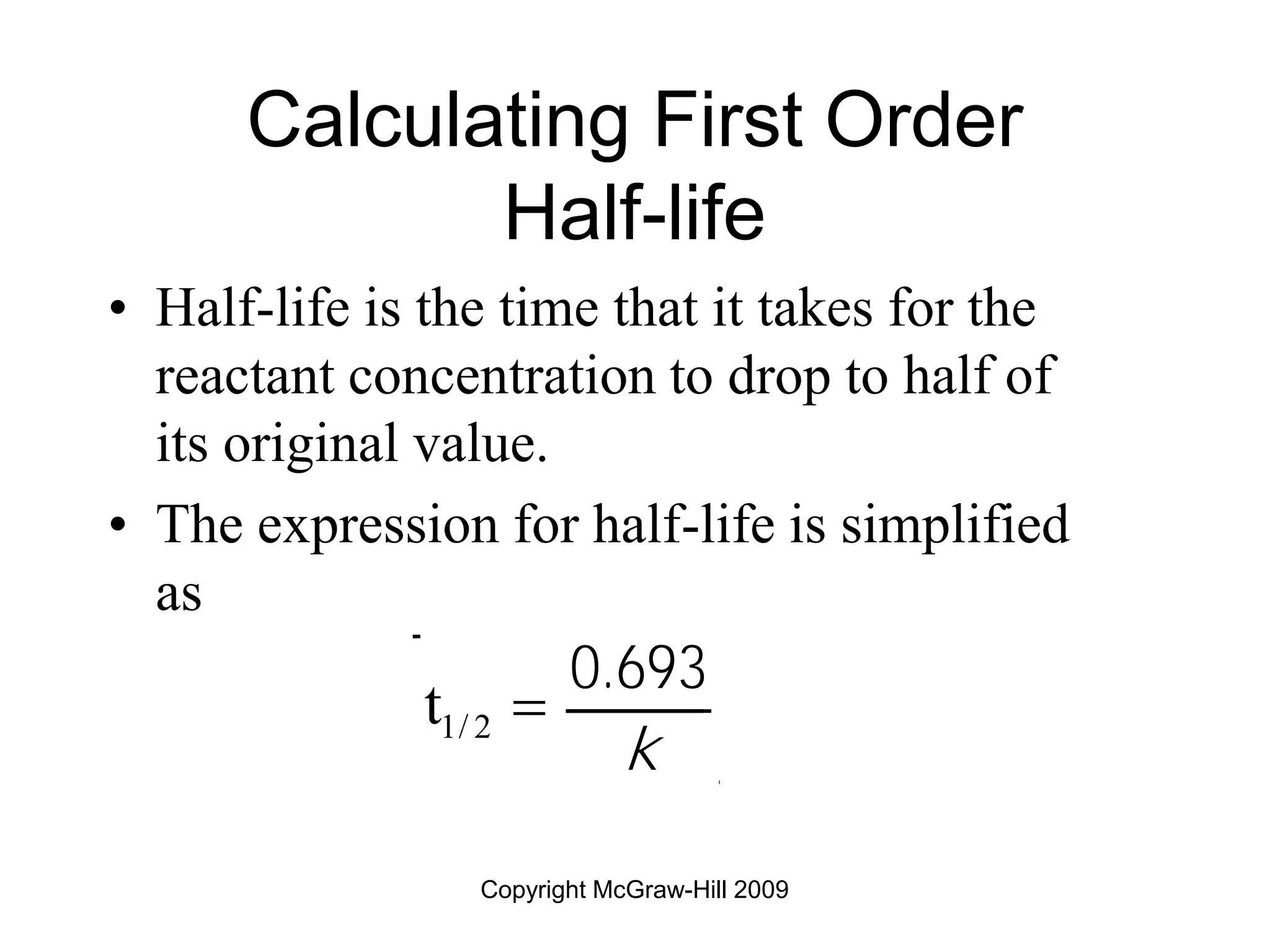
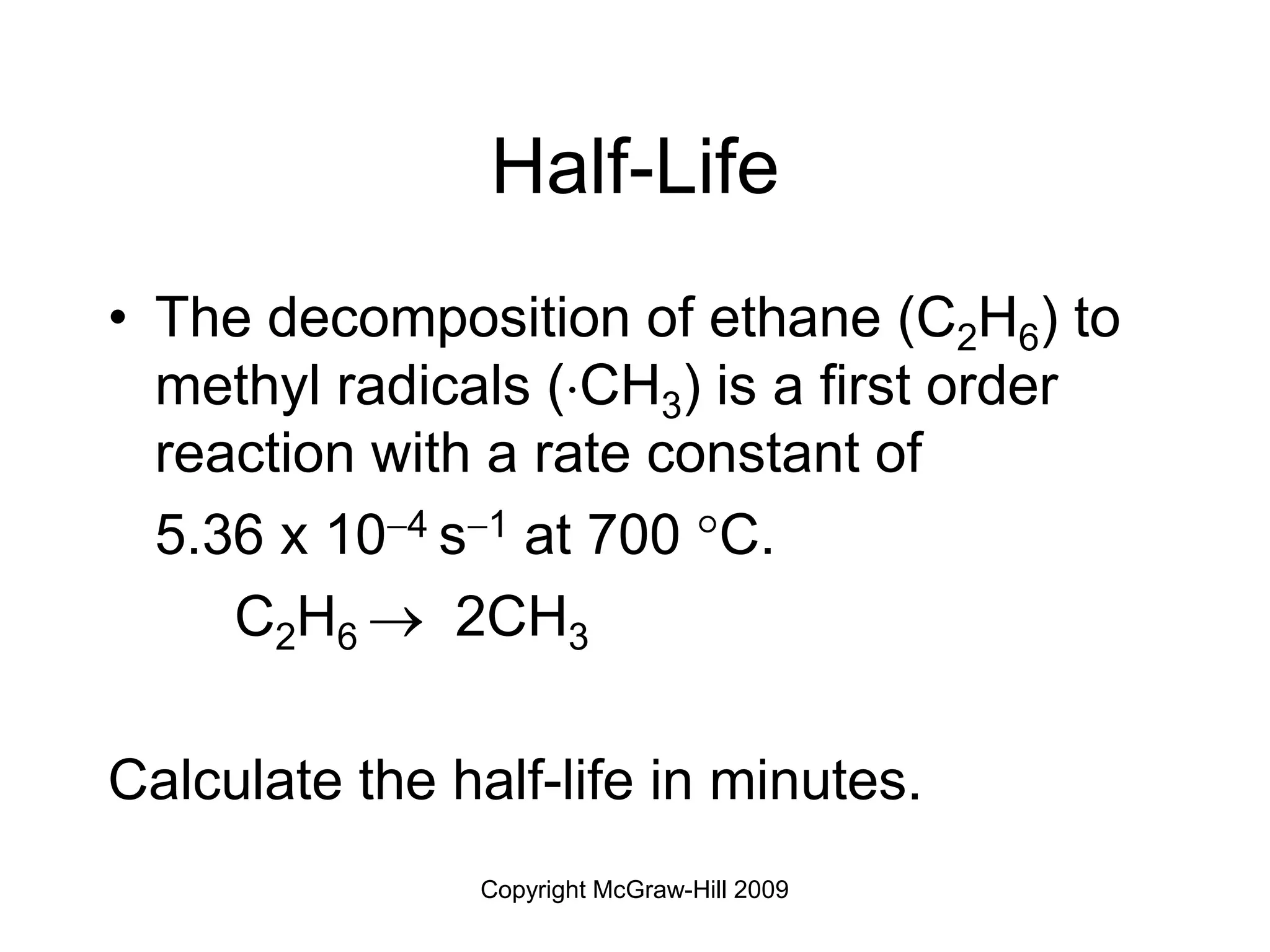
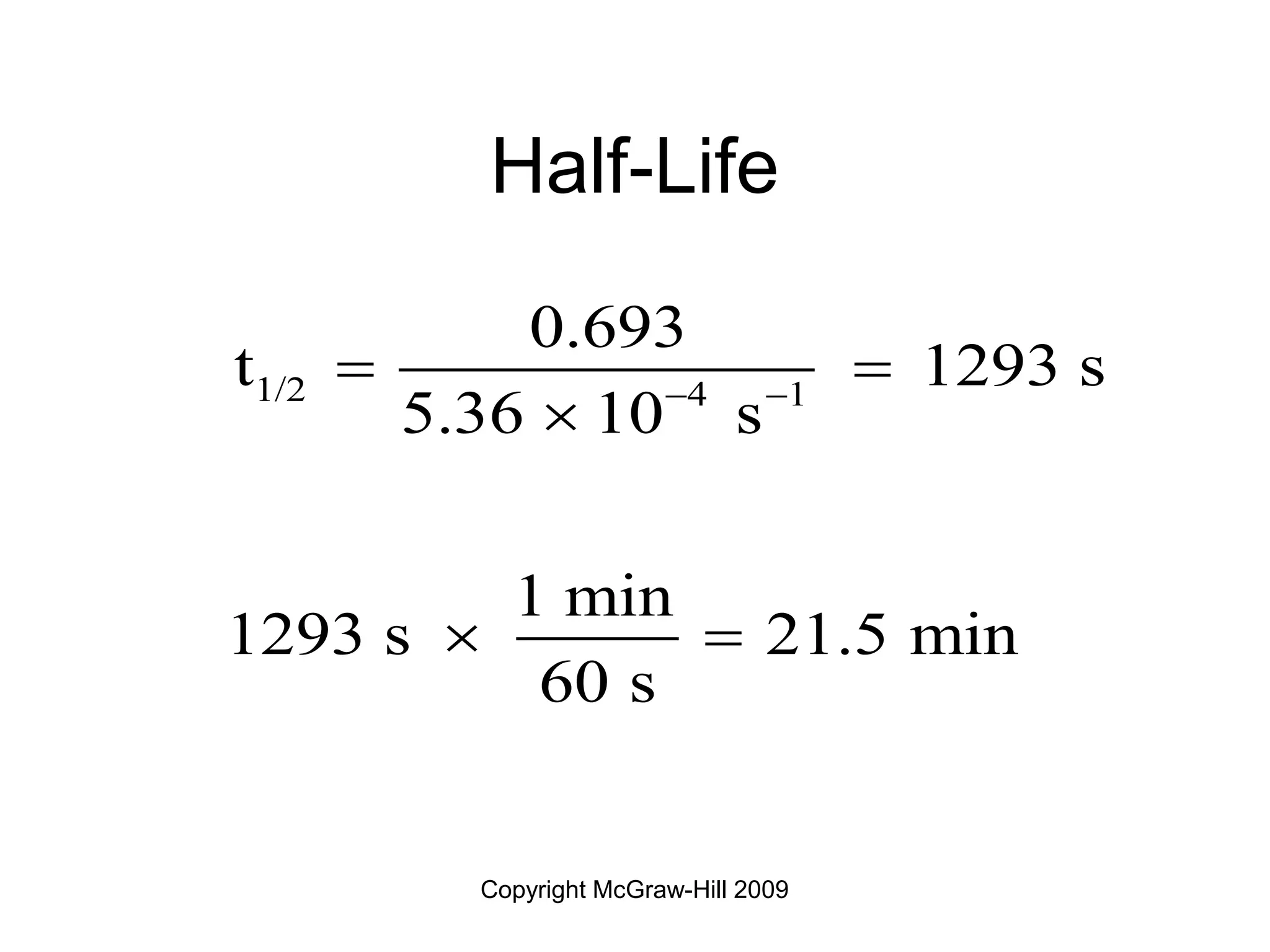
![Copyright McGraw-Hill 2009
Dependence of Reactant
Concentration on Time
Second-order reactions may be expressed in
several ways
• Example: A product
rate = k[A]2
[A]
rate
t
](https://image.slidesharecdn.com/chapter14lecturefinaljrb-240129164745-16be2f1a/75/chapter14_lecture_finalJRB-ppt-41-2048.jpg)
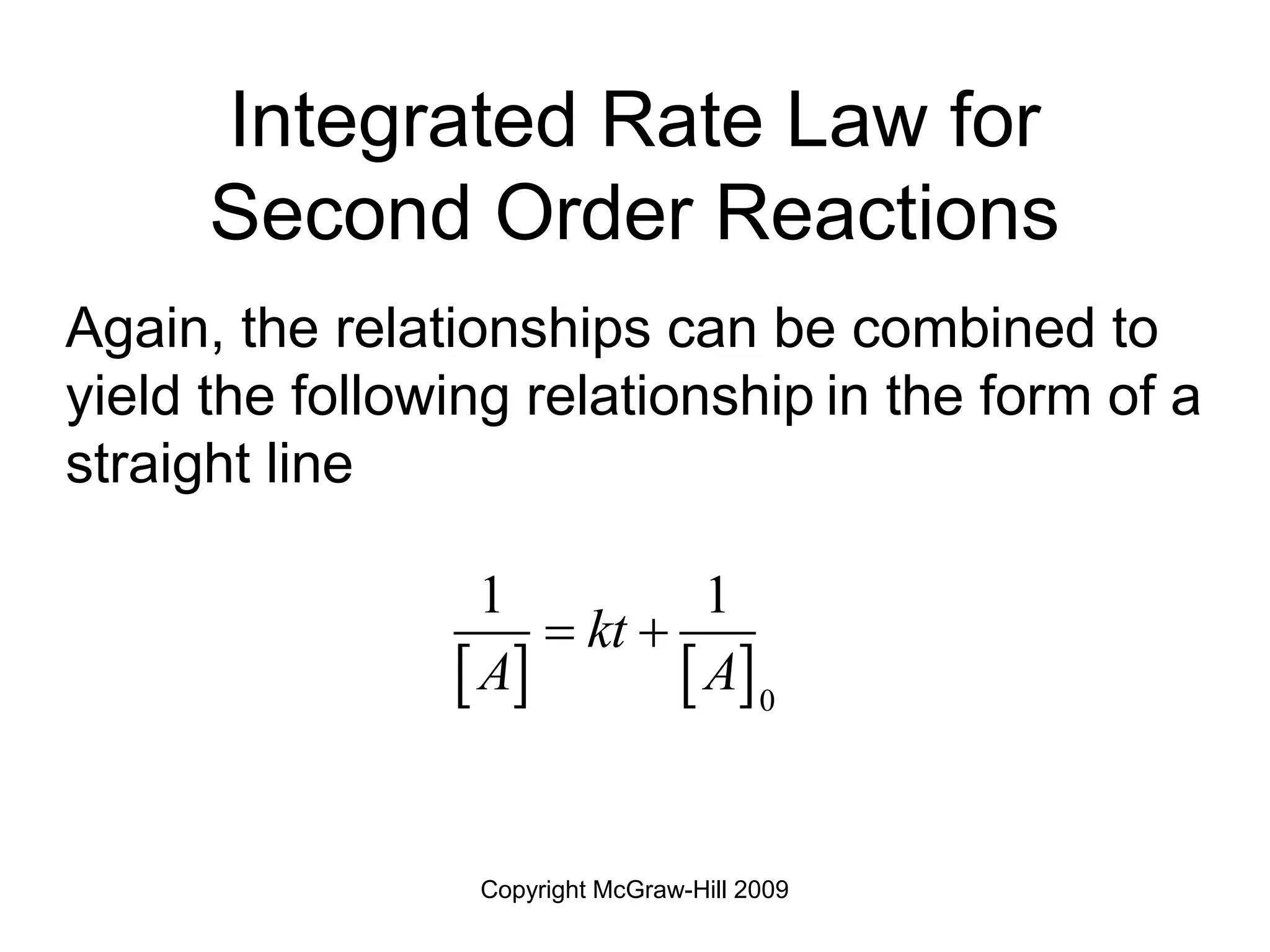
![Copyright McGraw-Hill 2009
Integrated Rate Law for
Second Order Reactions
• For a 2nd order reaction, a plot of 1/[A]
vs time yields a straight line
• The slope = k (the rate constant)](https://image.slidesharecdn.com/chapter14lecturefinaljrb-240129164745-16be2f1a/75/chapter14_lecture_finalJRB-ppt-43-2048.jpg)
![Copyright McGraw-Hill 2009
Calculating Second-Order
Half-life
The expression for half-life is simplified as
Note: half-life for 2nd order is inversely
proportional to the initial reaction
concentration
1/2
0
1
t
[A]
k
](https://image.slidesharecdn.com/chapter14lecturefinaljrb-240129164745-16be2f1a/75/chapter14_lecture_finalJRB-ppt-44-2048.jpg)
![Copyright McGraw-Hill 2009
Calculating Second Order
Half-life
I(g) + I(g) I2(g)
The reaction is second order and has a rate
constant of 7.0 x 109 M1 s1 at 23C.
a) If the initial [I] is 0.086 M, calculate the
concentration after 2.0 min.
b) Calculate the half-life of the reaction
when the initial [I] is 0.60 M and when the
[I] is 0.42 M.](https://image.slidesharecdn.com/chapter14lecturefinaljrb-240129164745-16be2f1a/75/chapter14_lecture_finalJRB-ppt-45-2048.jpg)
![Copyright McGraw-Hill 2009
a) Use integrated rate equation for 2nd
order
9 1 1
11 1
12
11 1
1 1
(7.0 10 s ) 120s
A 0.086
8.4 10
1
[A] 1.2 10
8.4 10
M
M
M
M
M
](https://image.slidesharecdn.com/chapter14lecturefinaljrb-240129164745-16be2f1a/75/chapter14_lecture_finalJRB-ppt-46-2048.jpg)
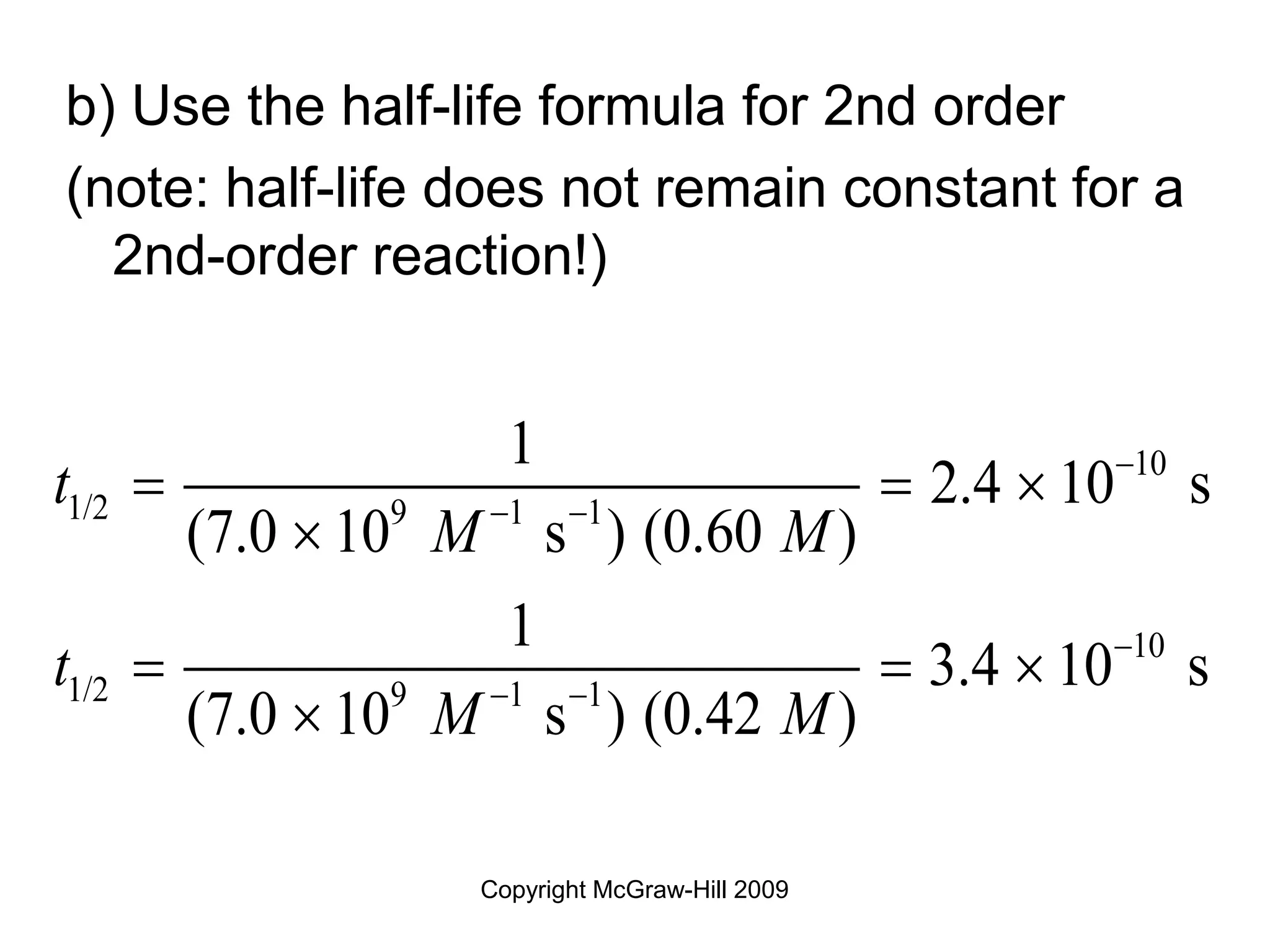
![Copyright McGraw-Hill 2009
Zero Order
Zero Order reactions may exist but are
relatively rare
• Example: A product
rate = k[A]0 = k
• Thus, a plot of [A] vs time yields a
straight line.](https://image.slidesharecdn.com/chapter14lecturefinaljrb-240129164745-16be2f1a/75/chapter14_lecture_finalJRB-ppt-48-2048.jpg)
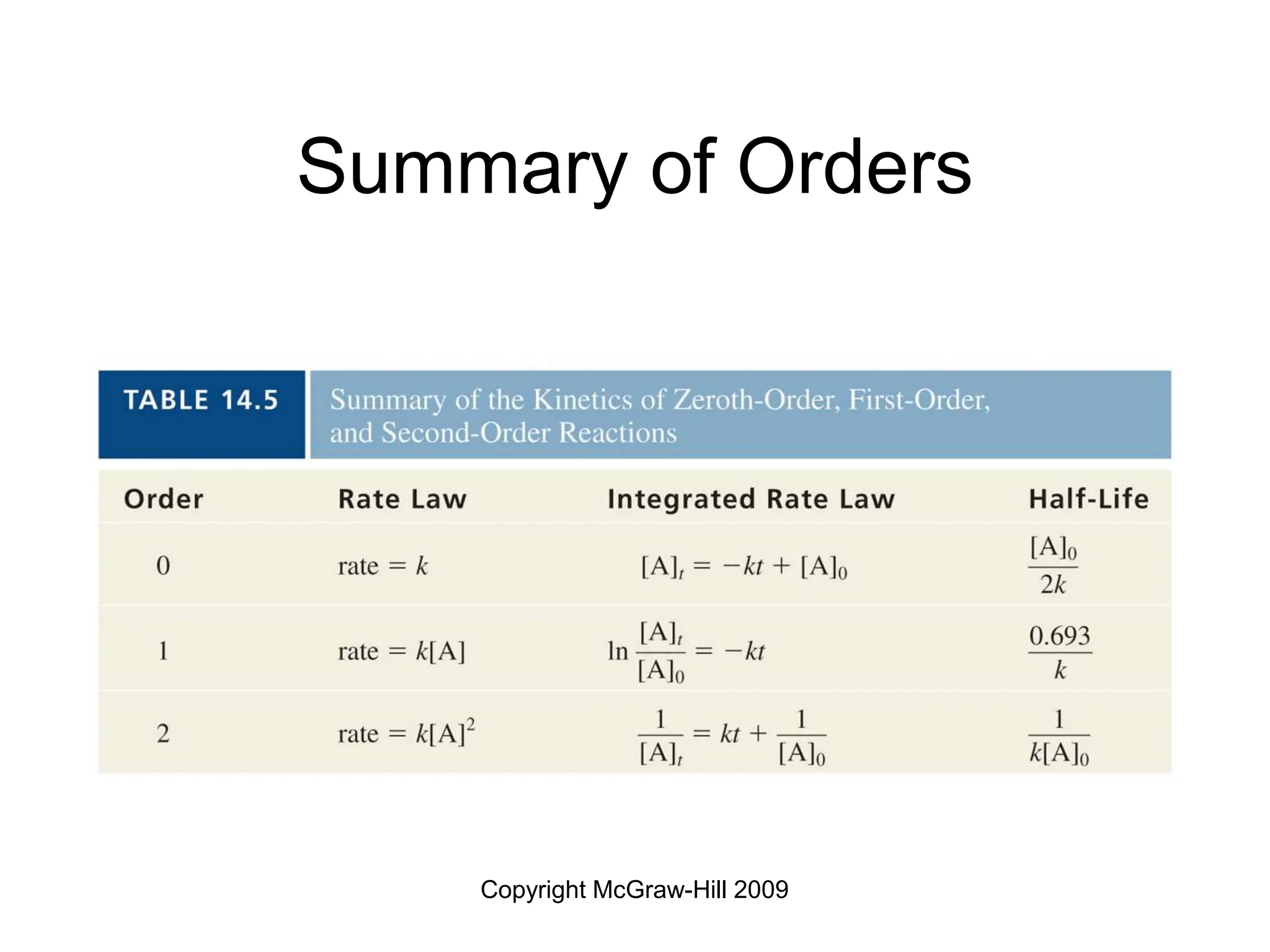
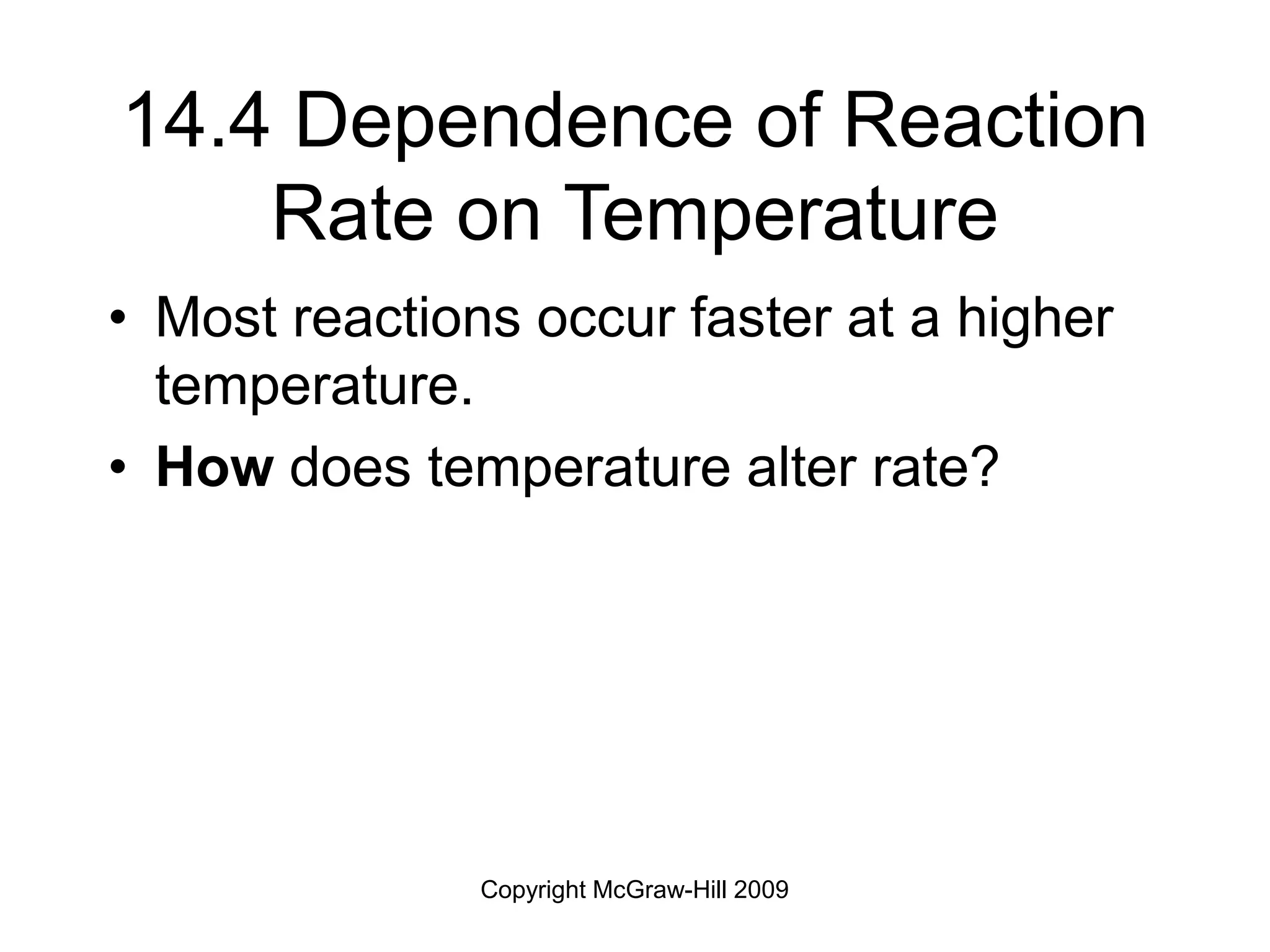
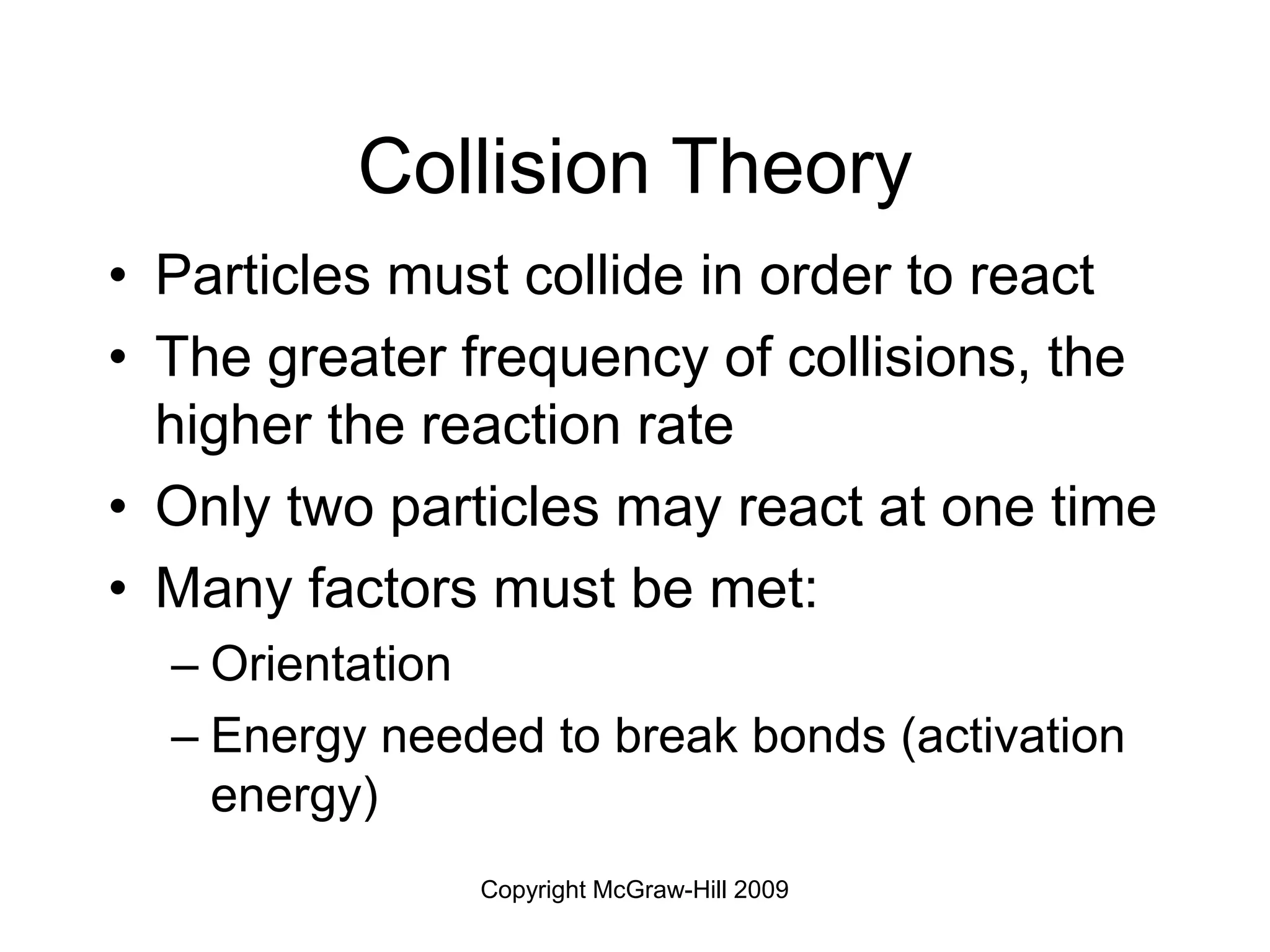
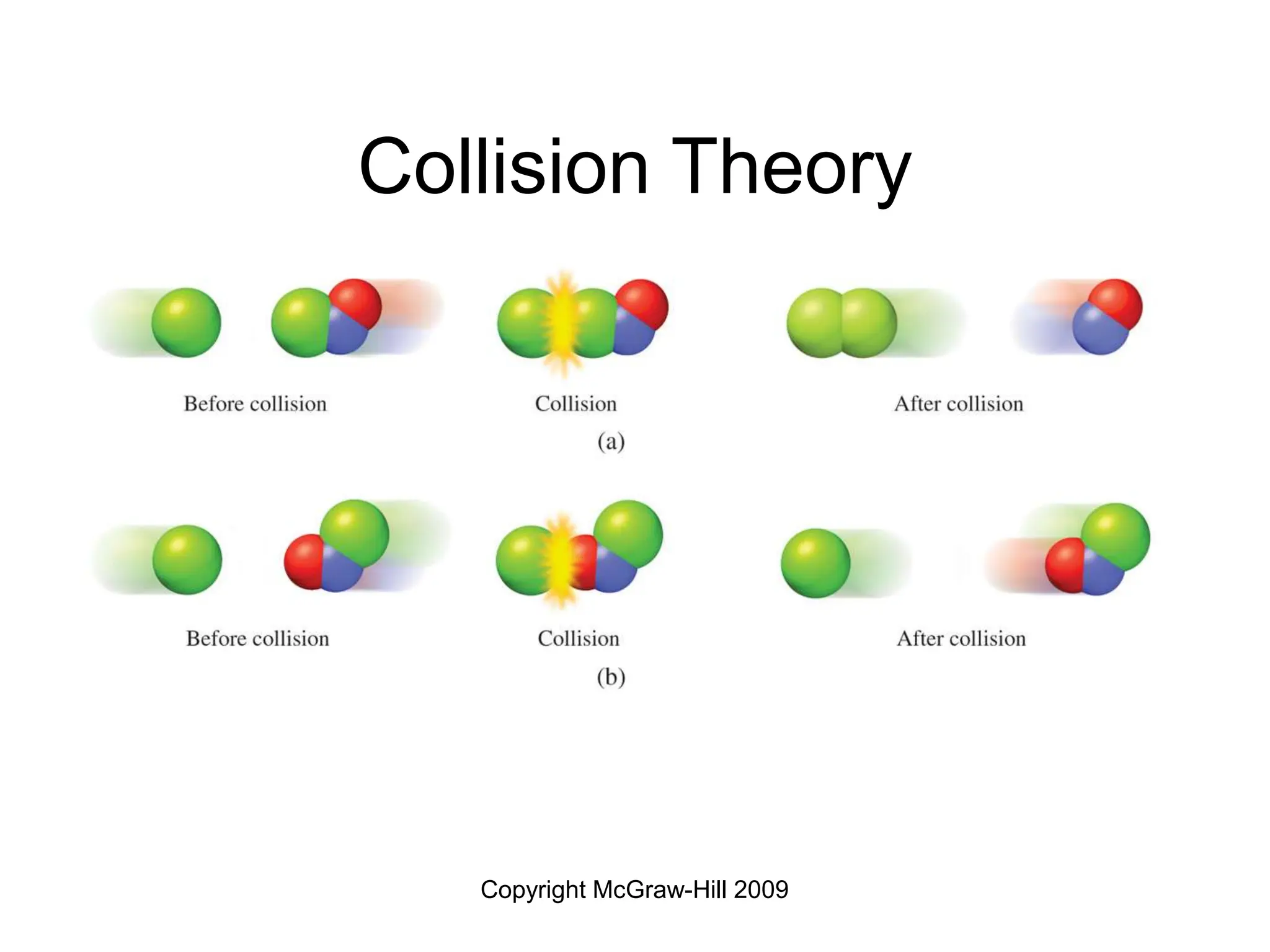
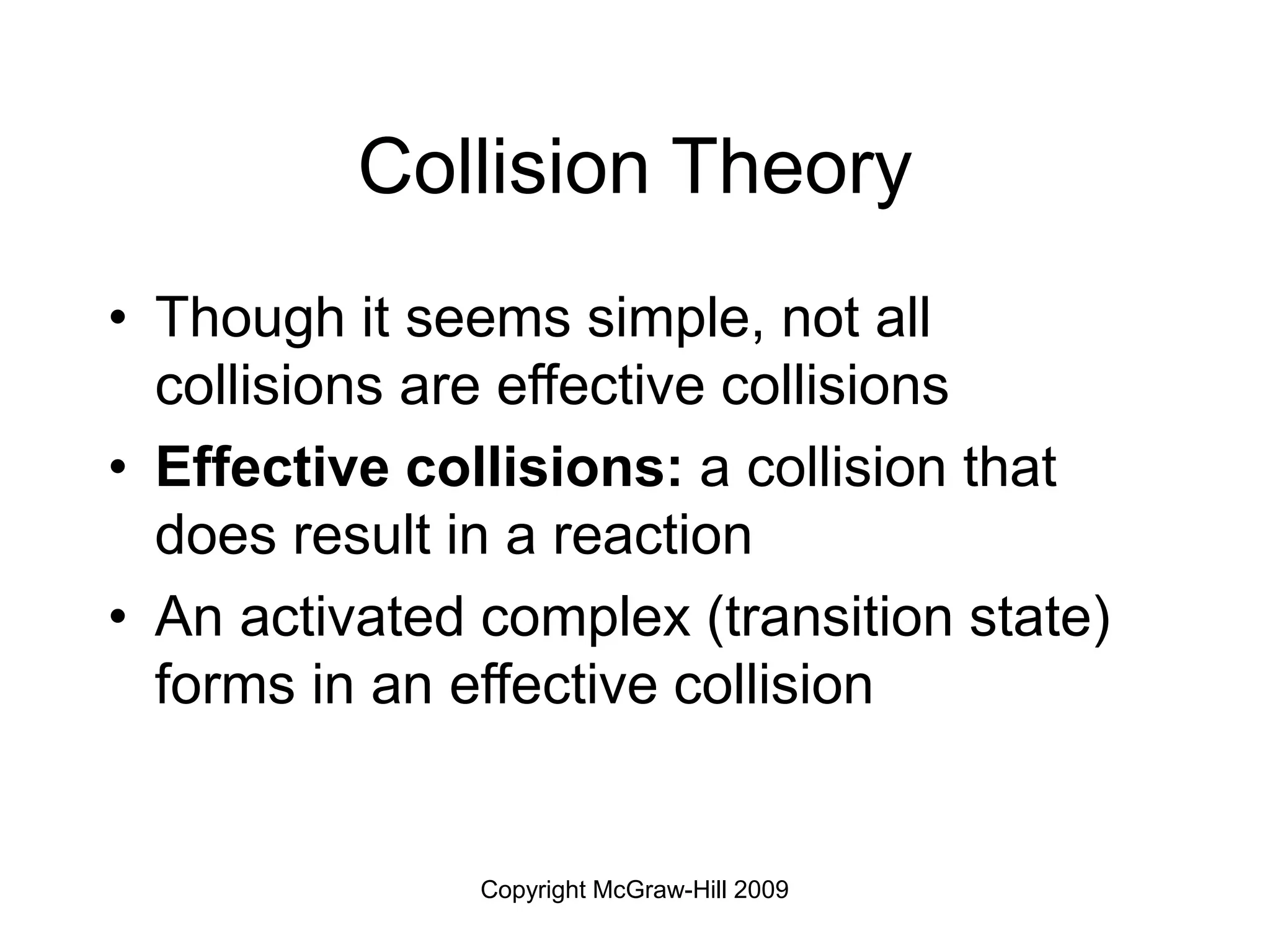
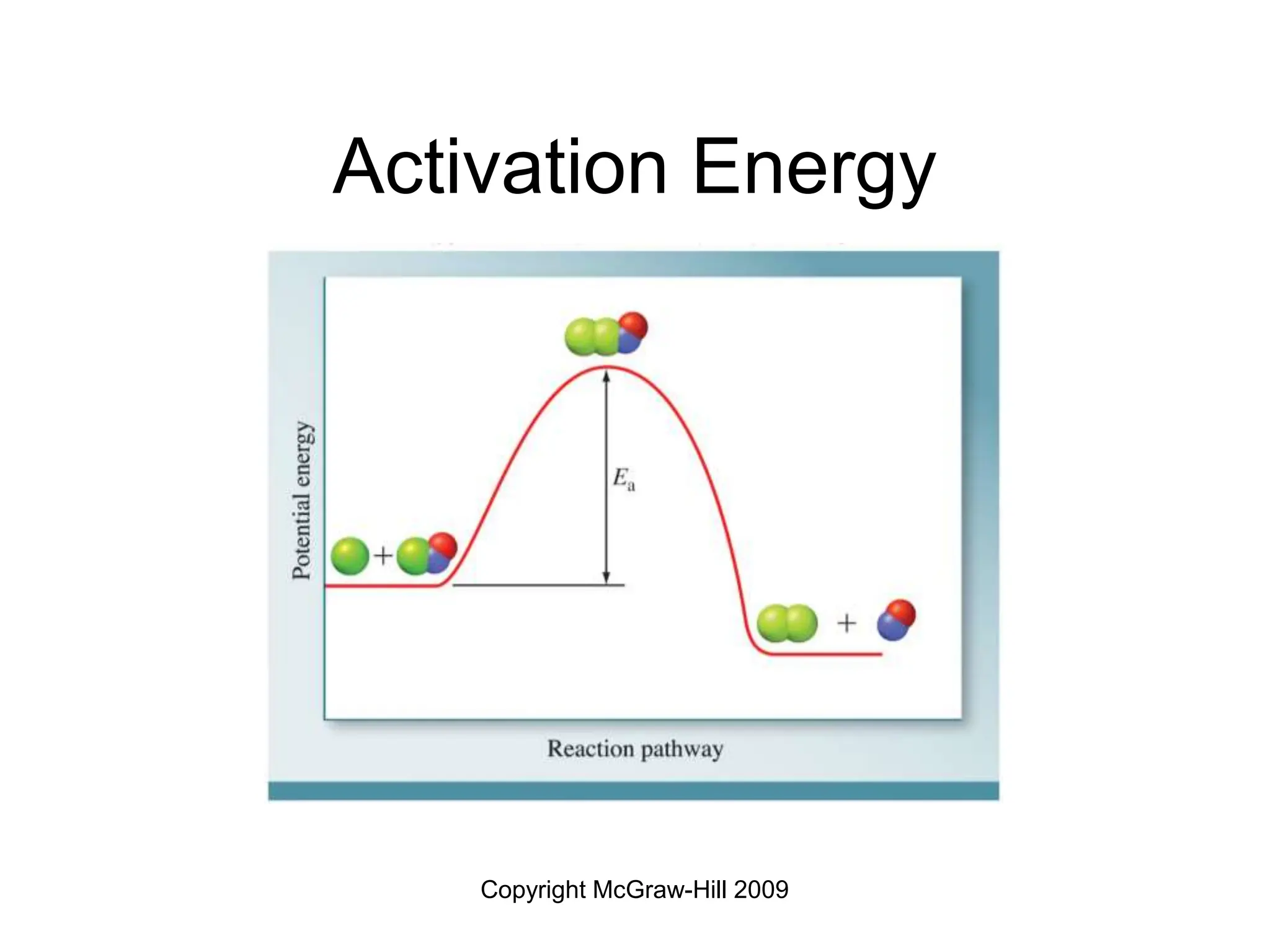
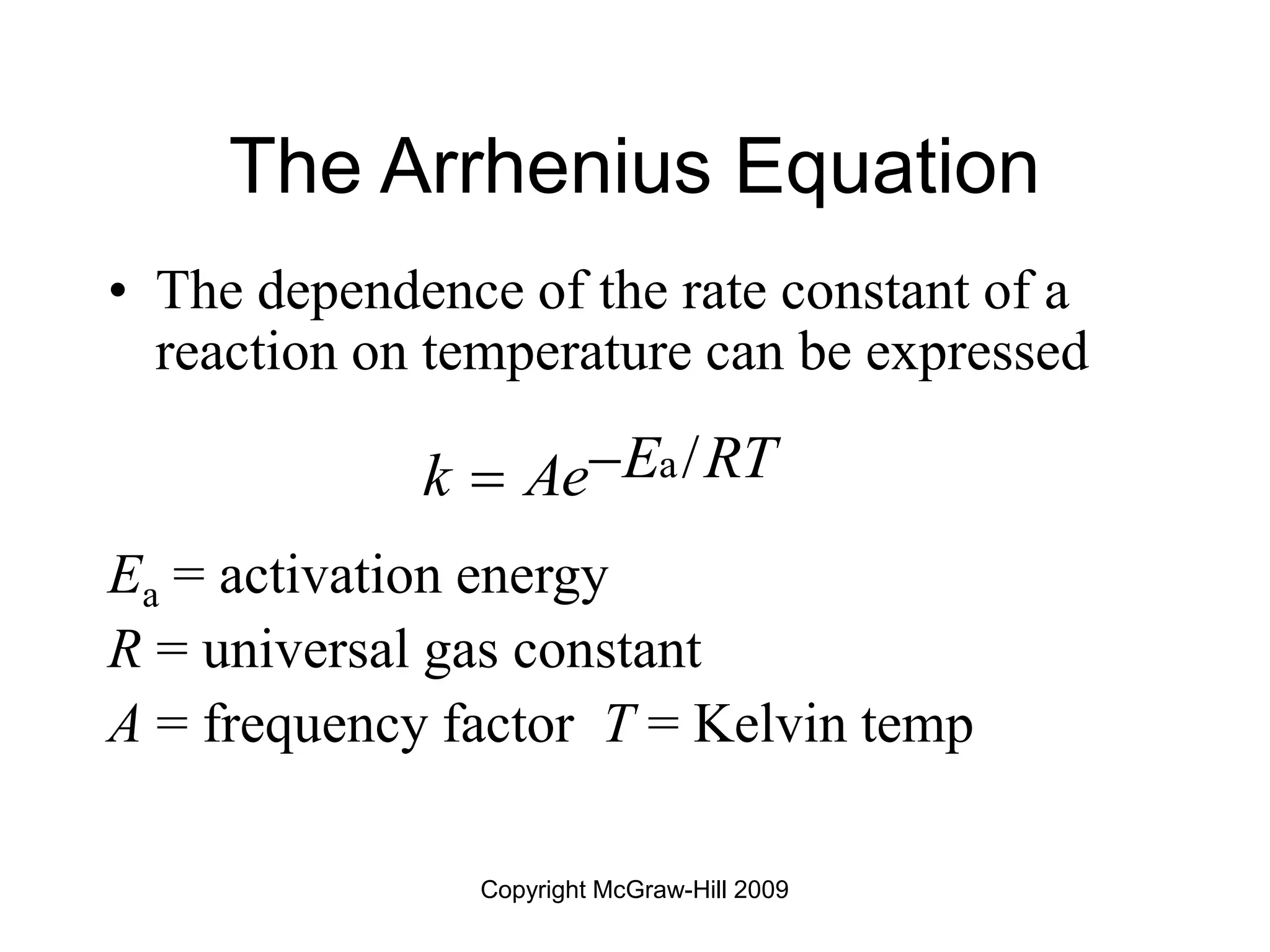
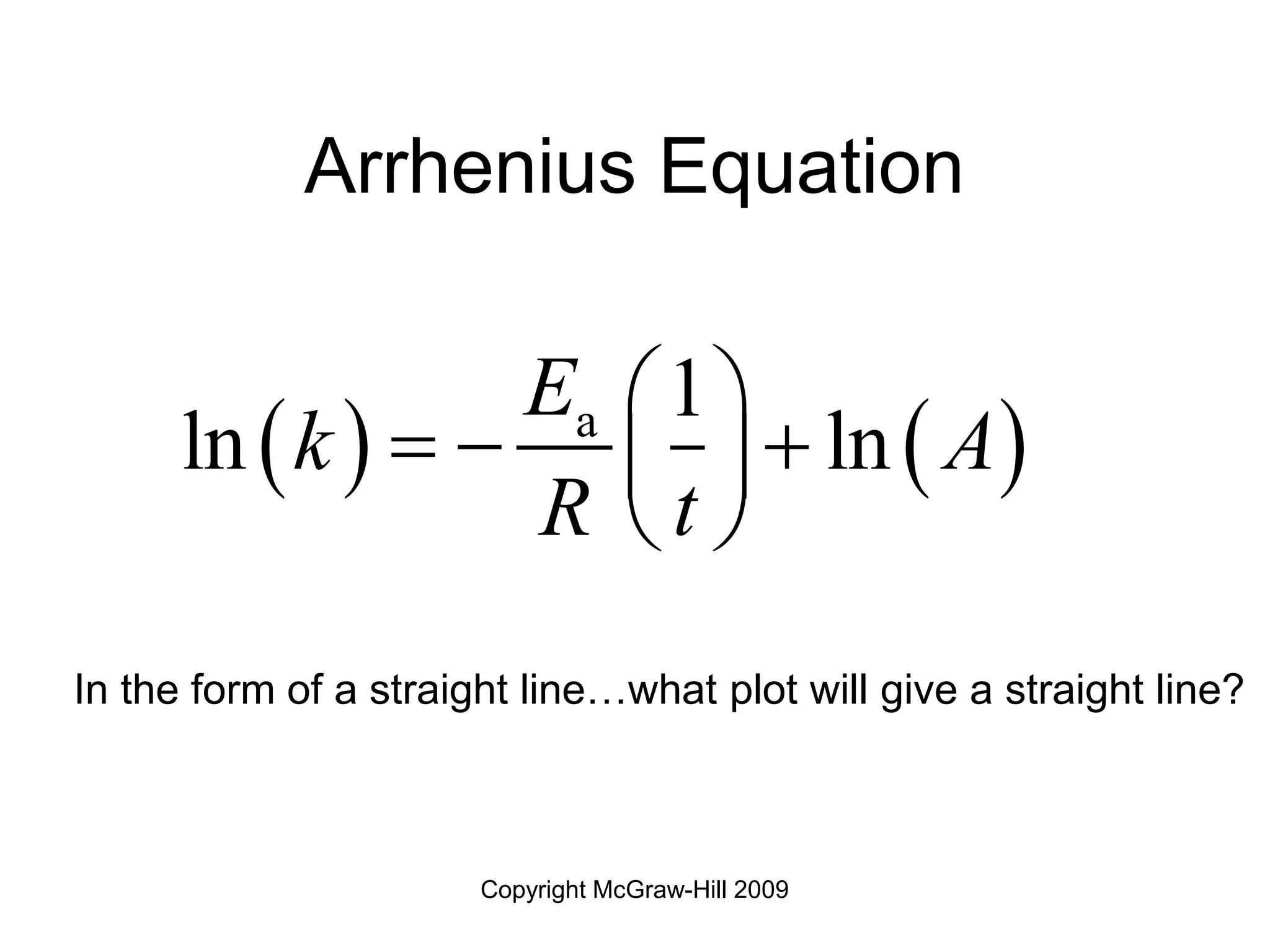
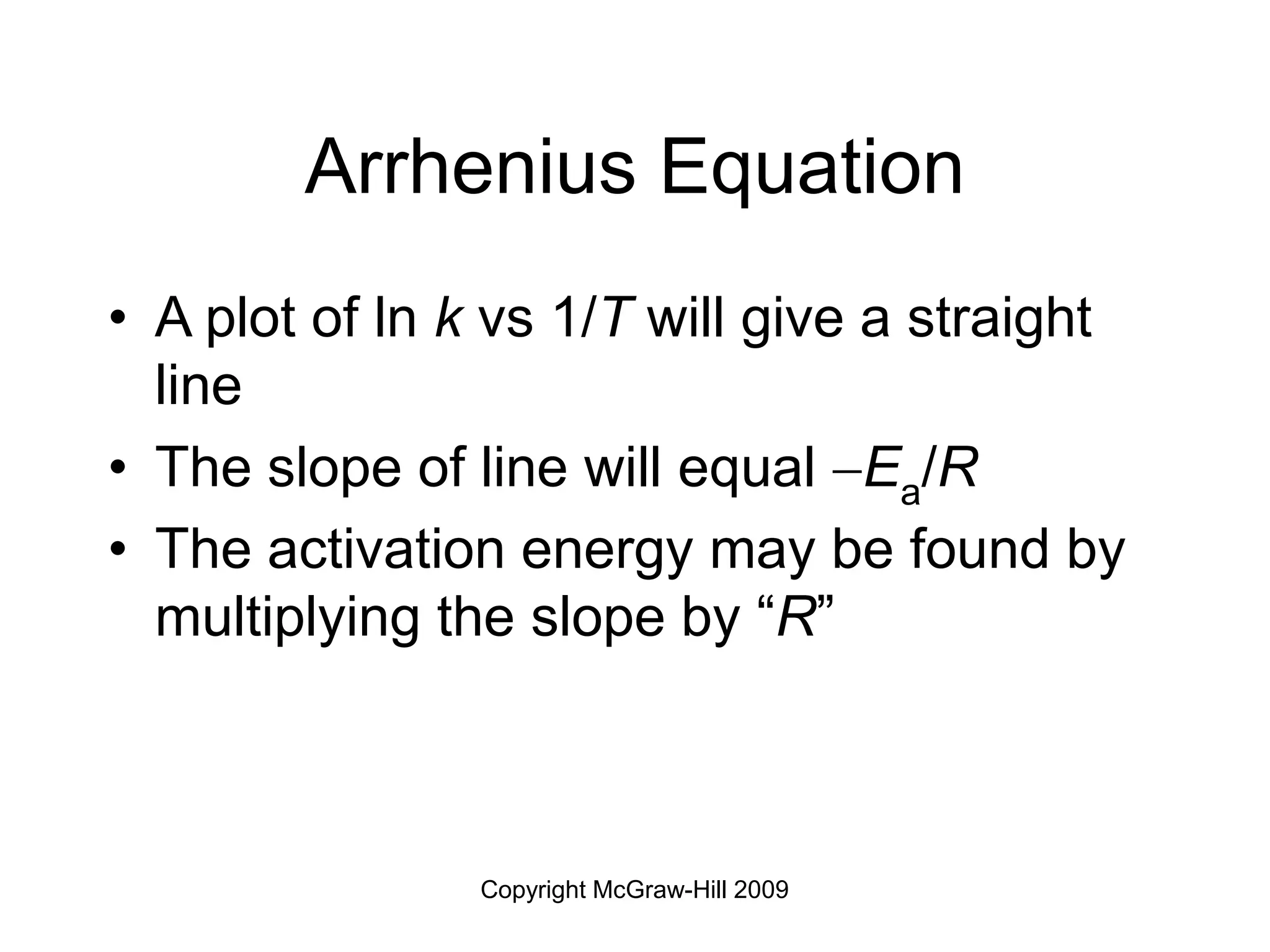
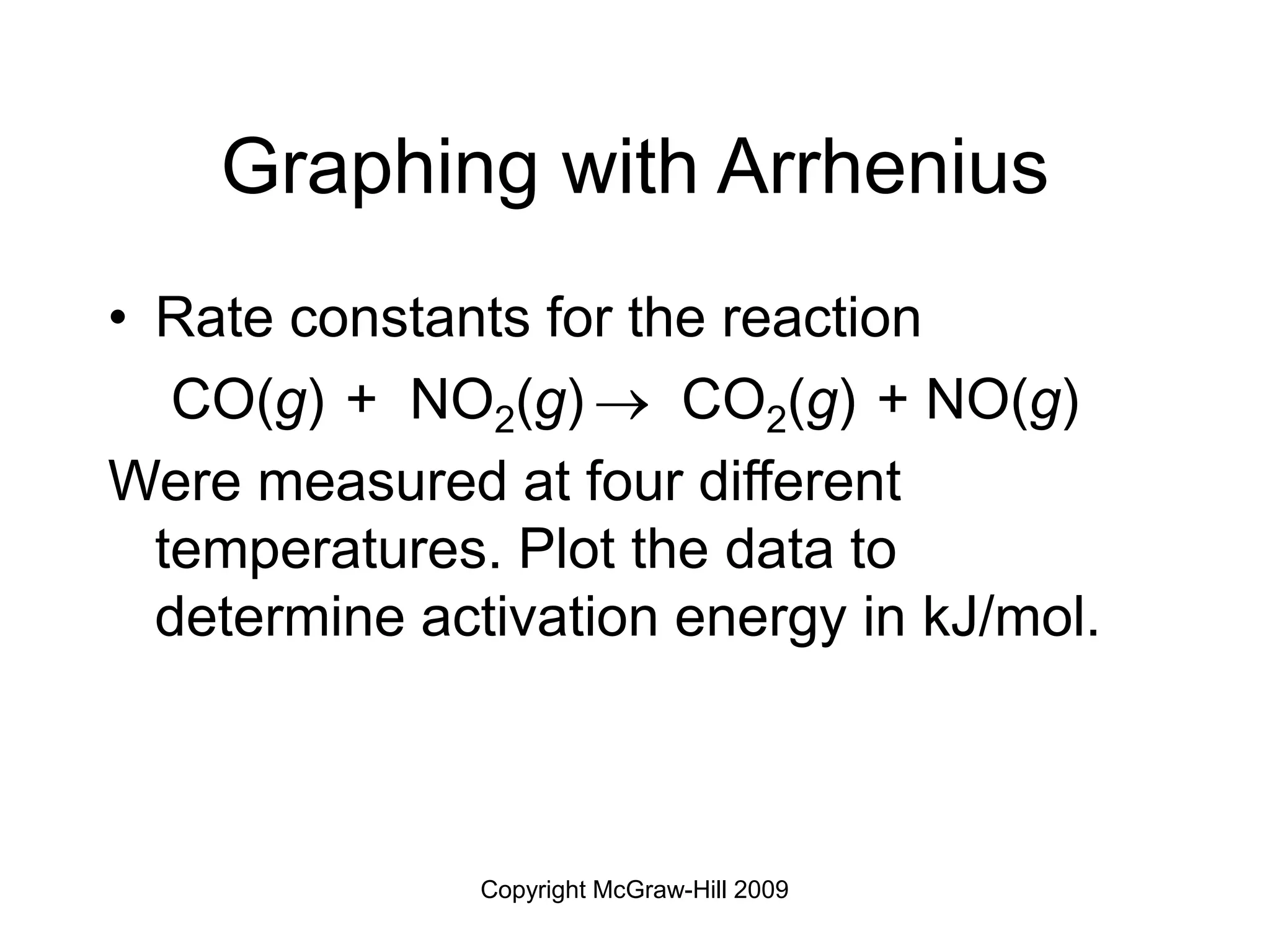
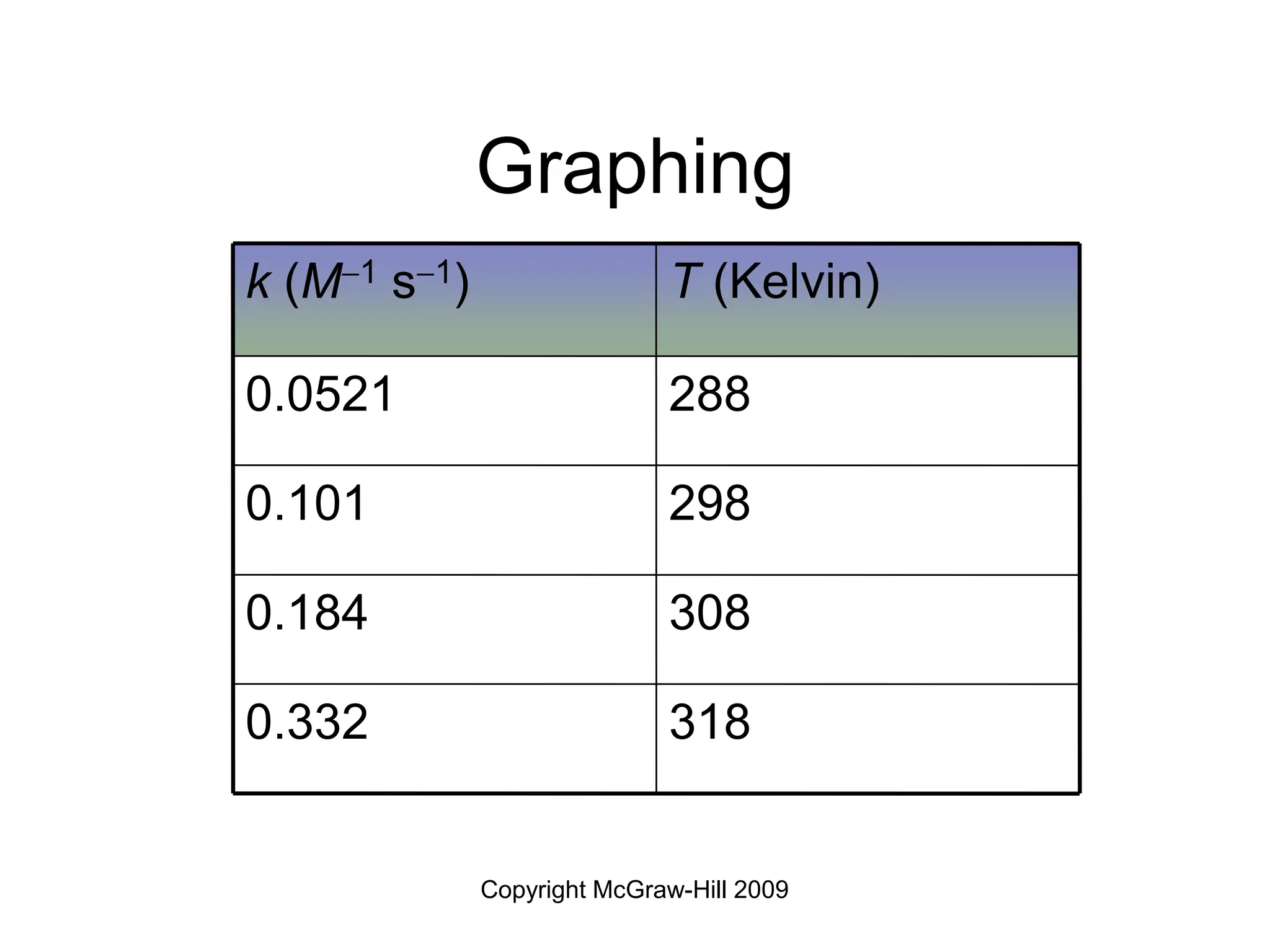
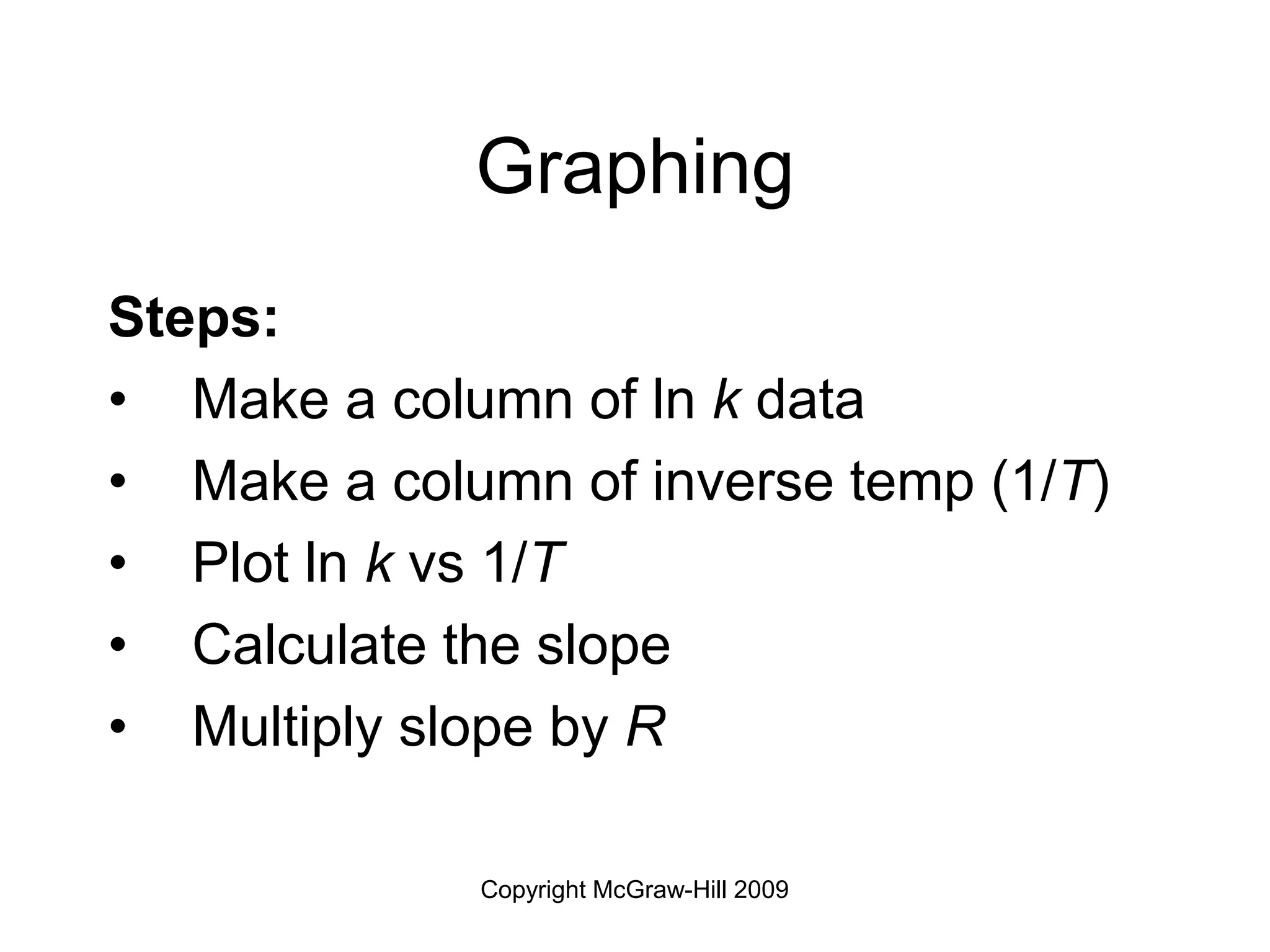
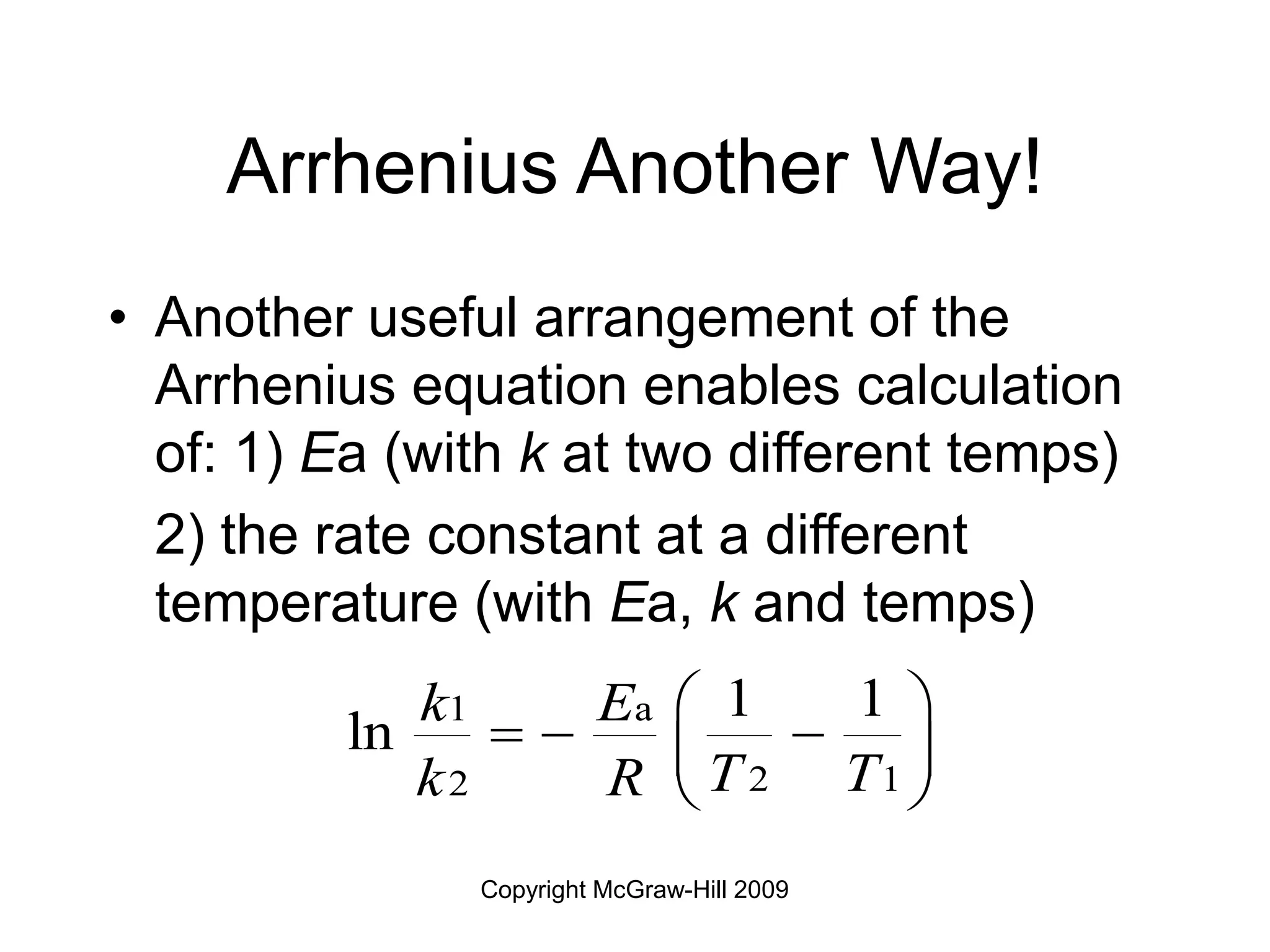
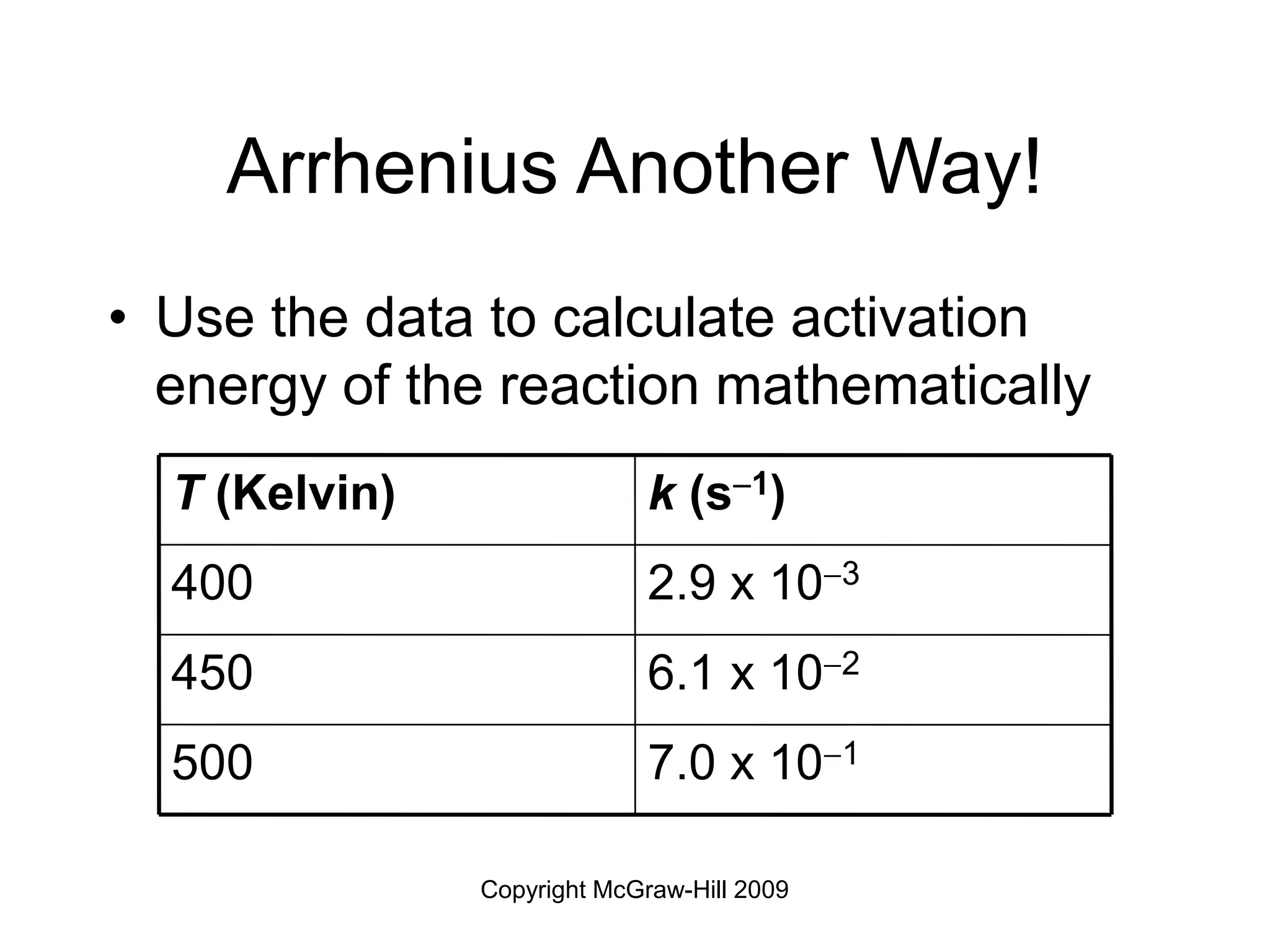
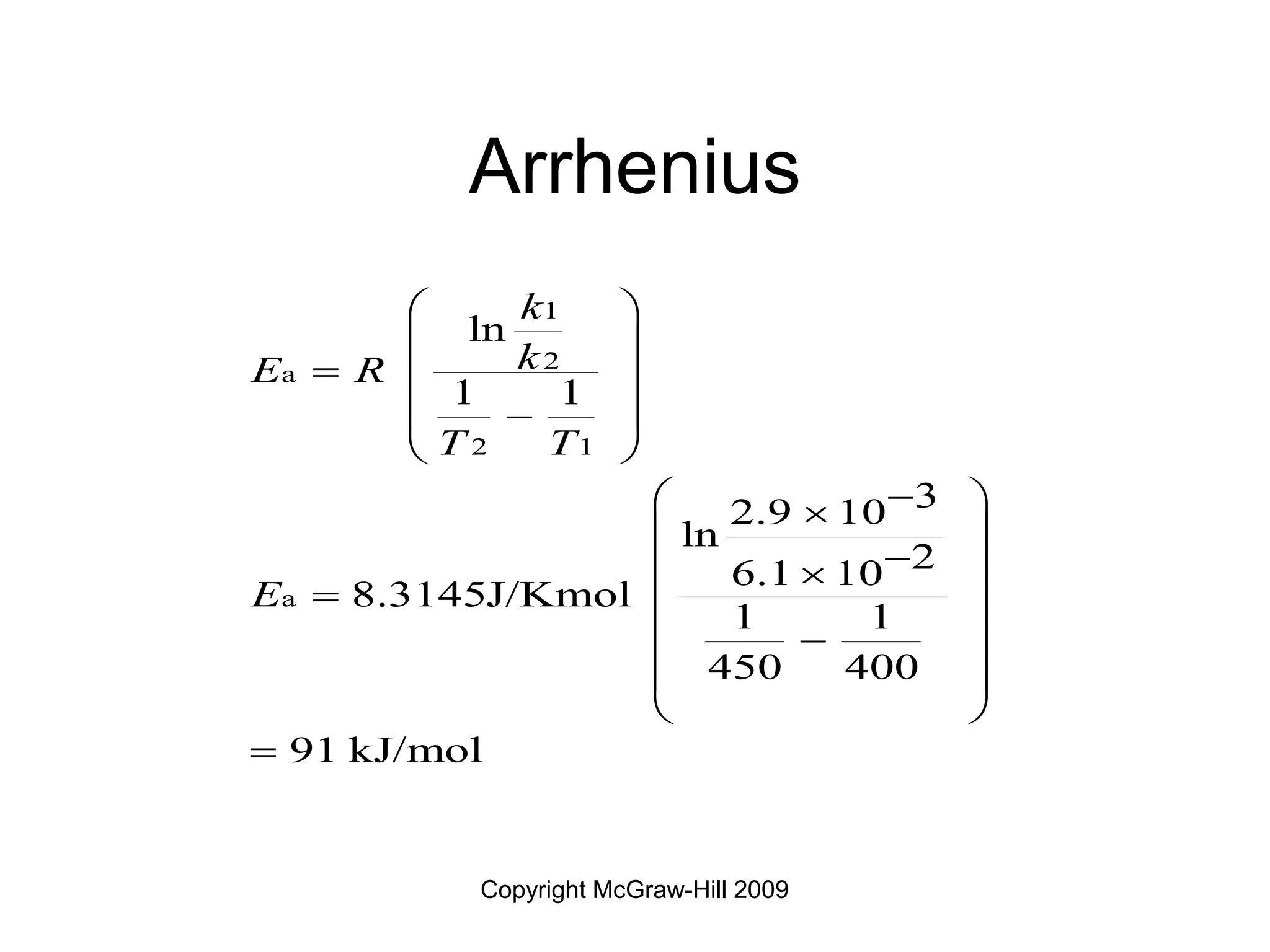
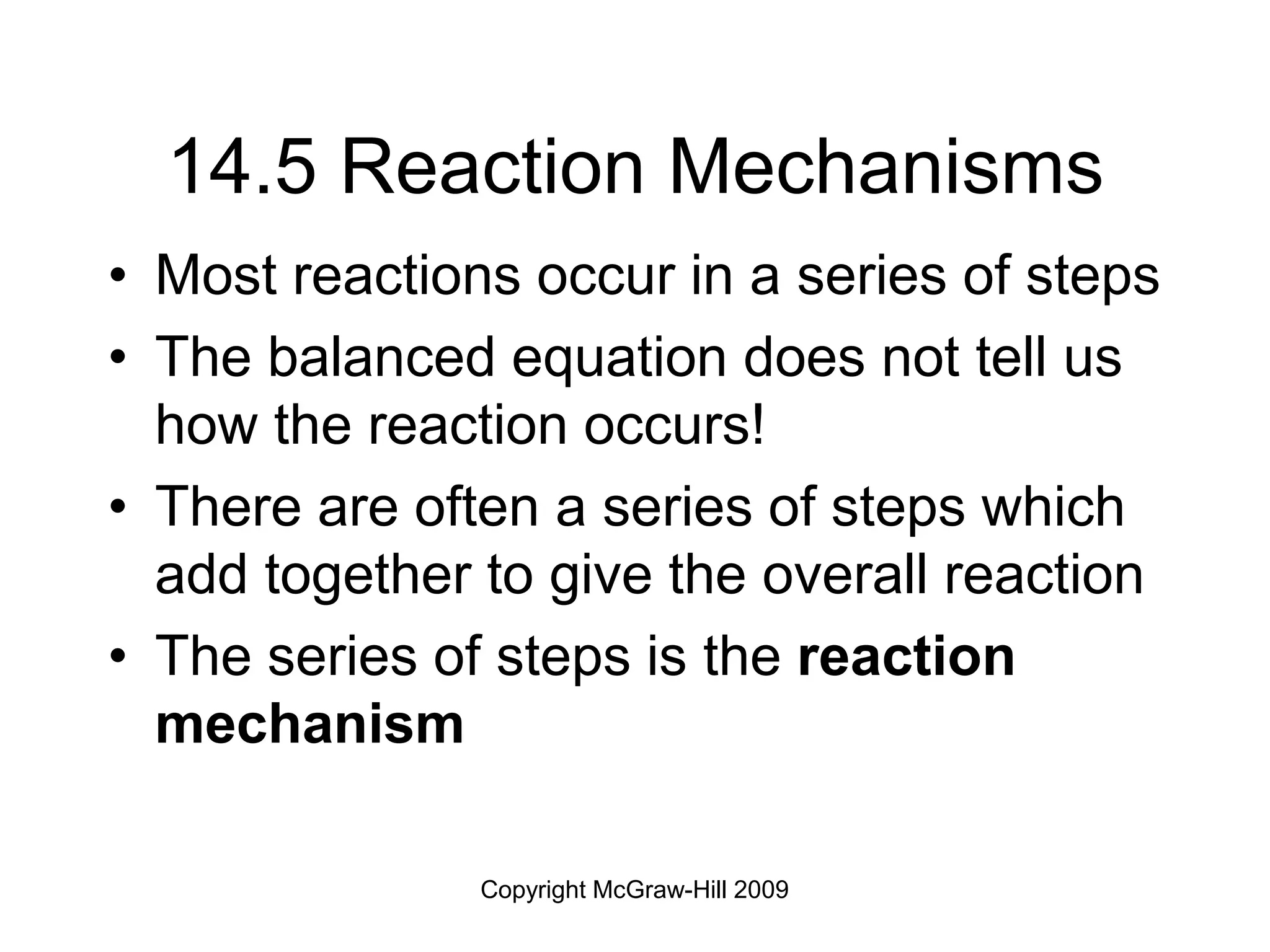
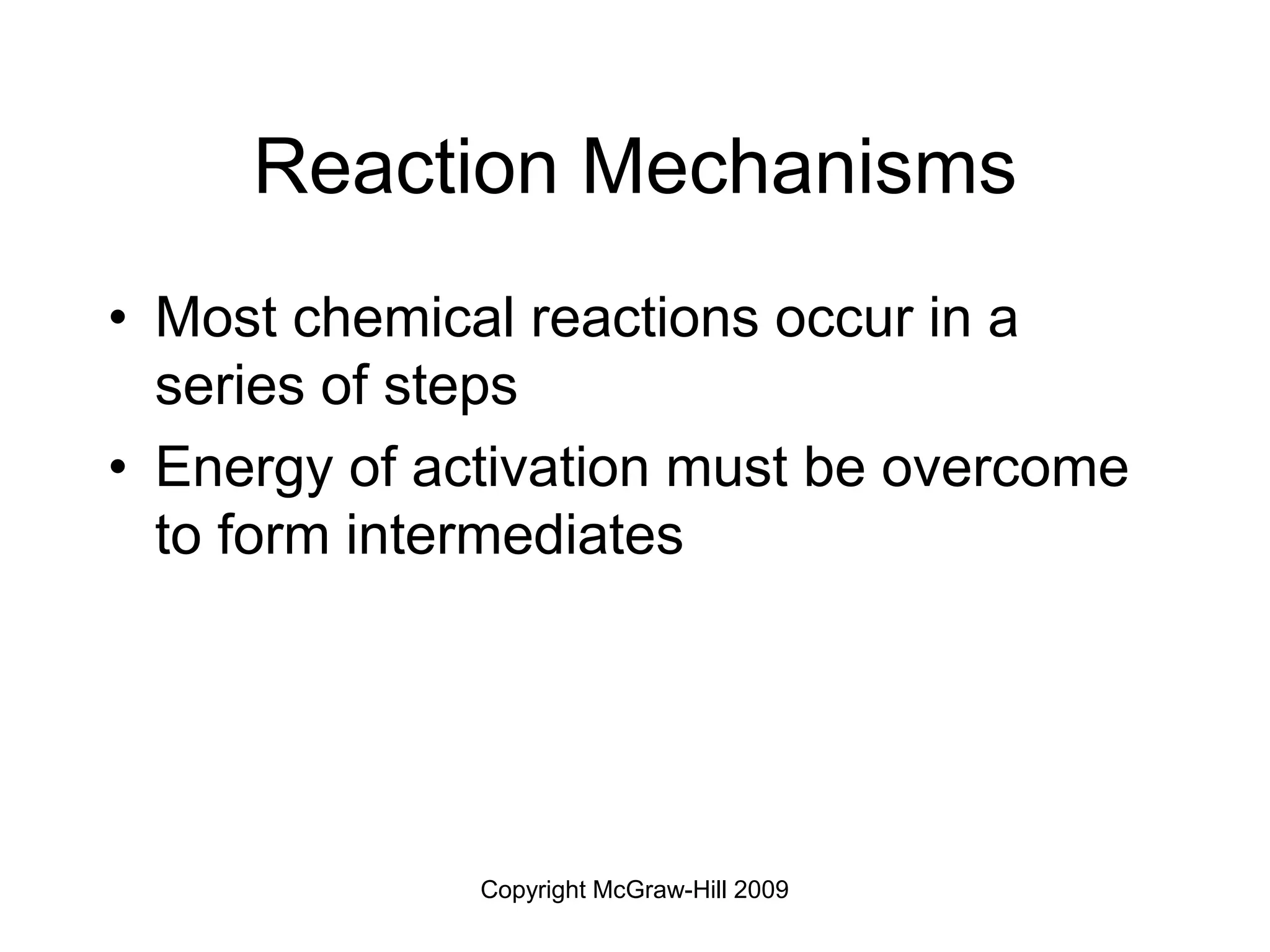
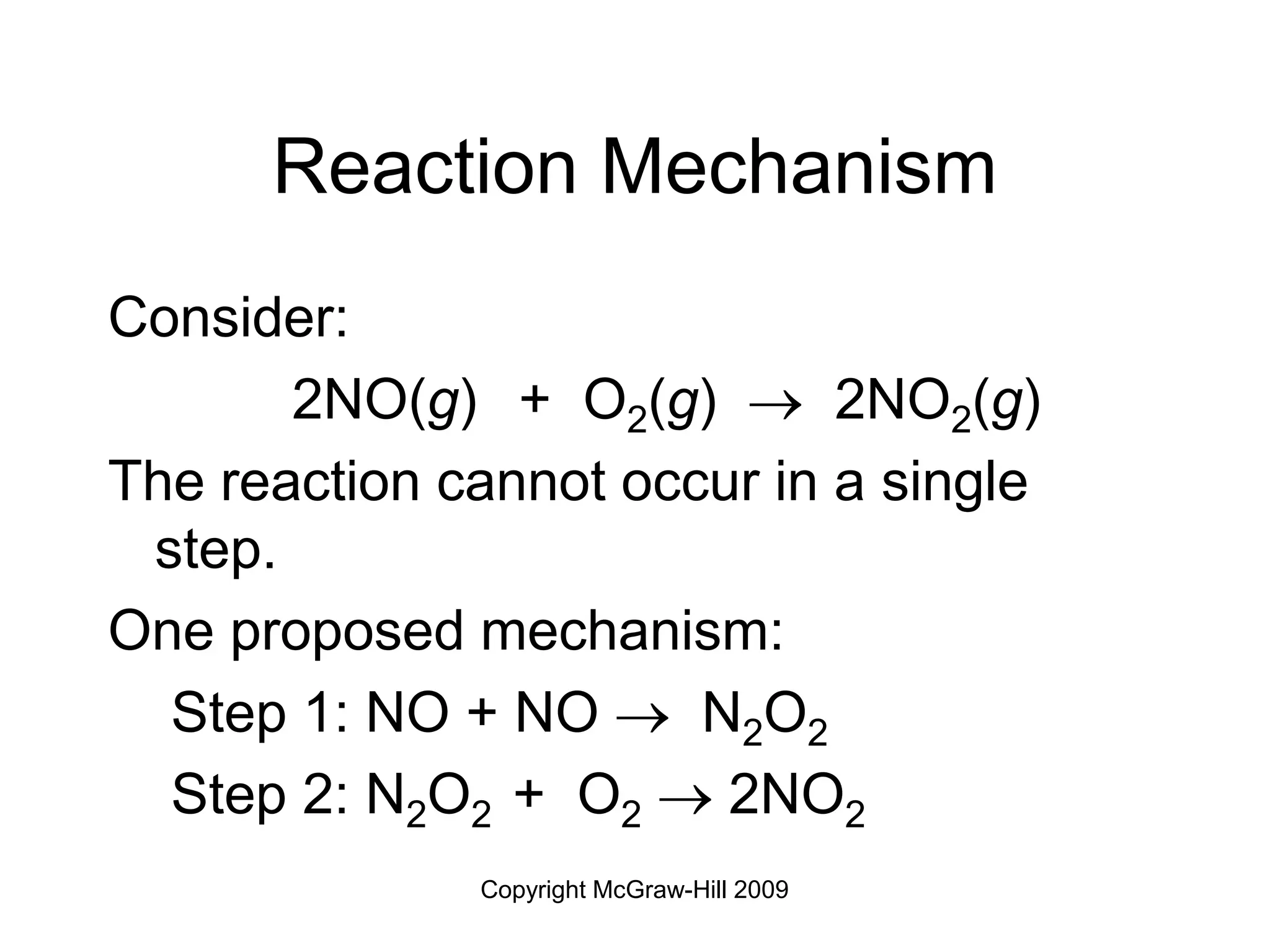
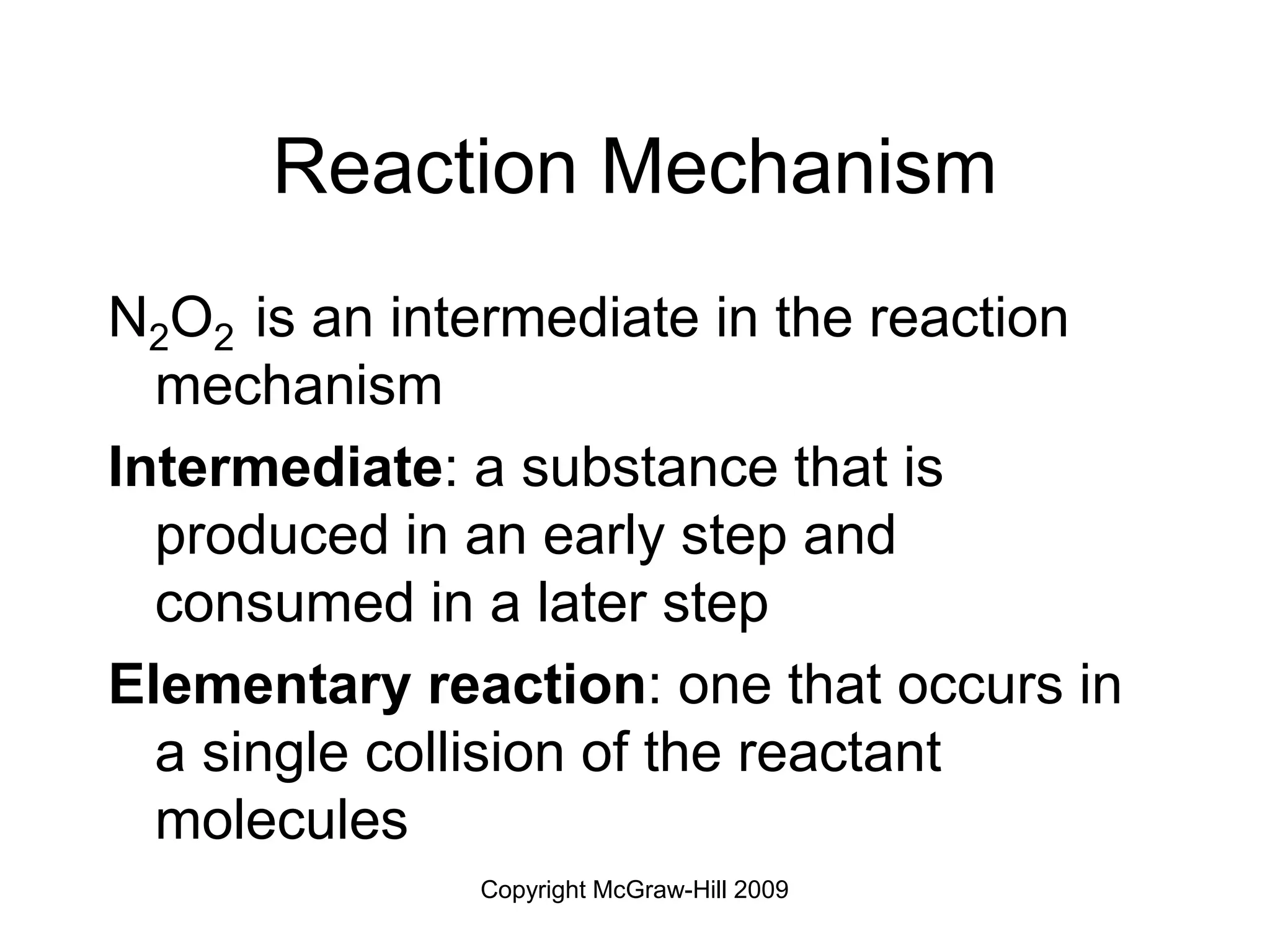

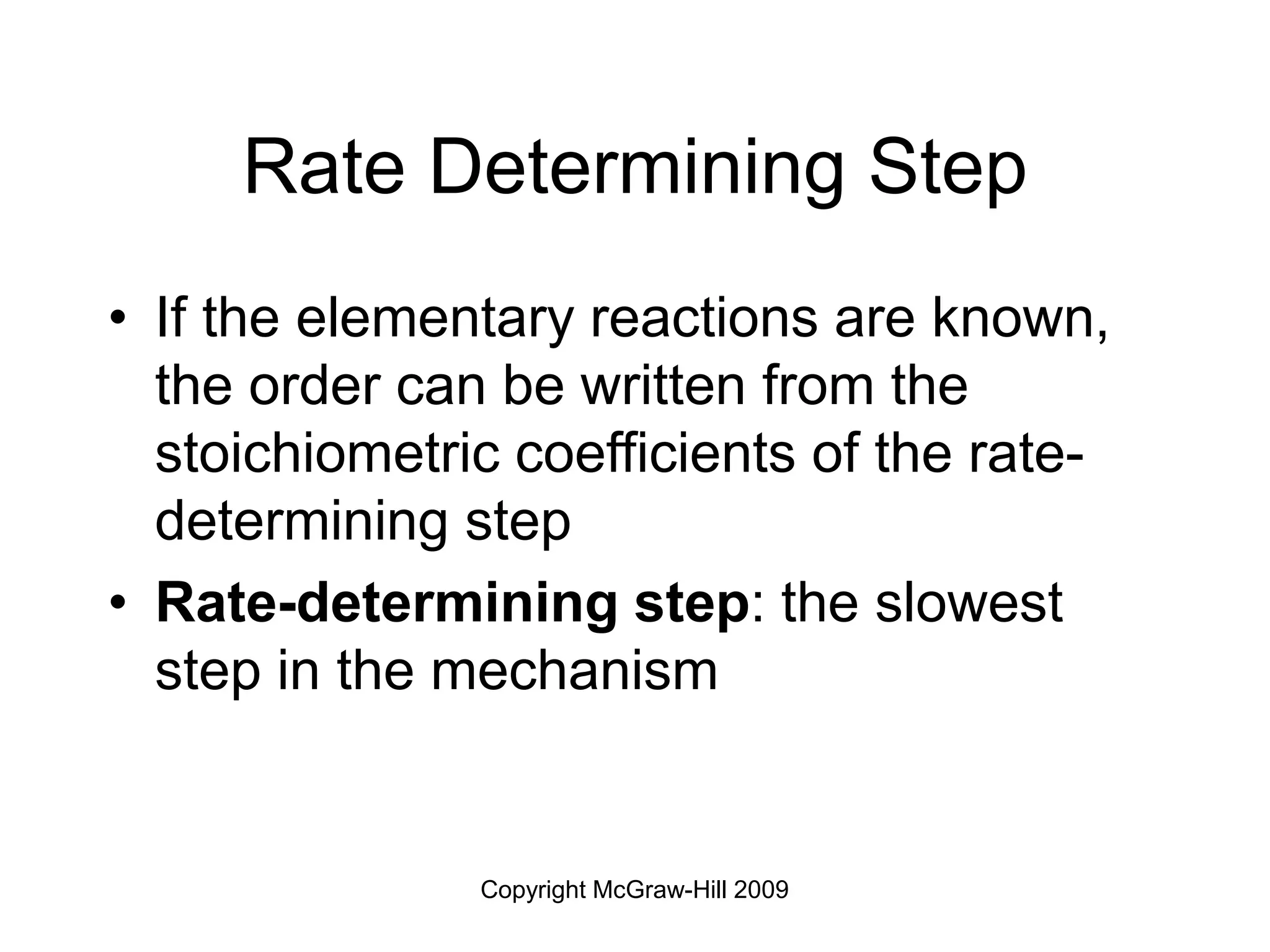
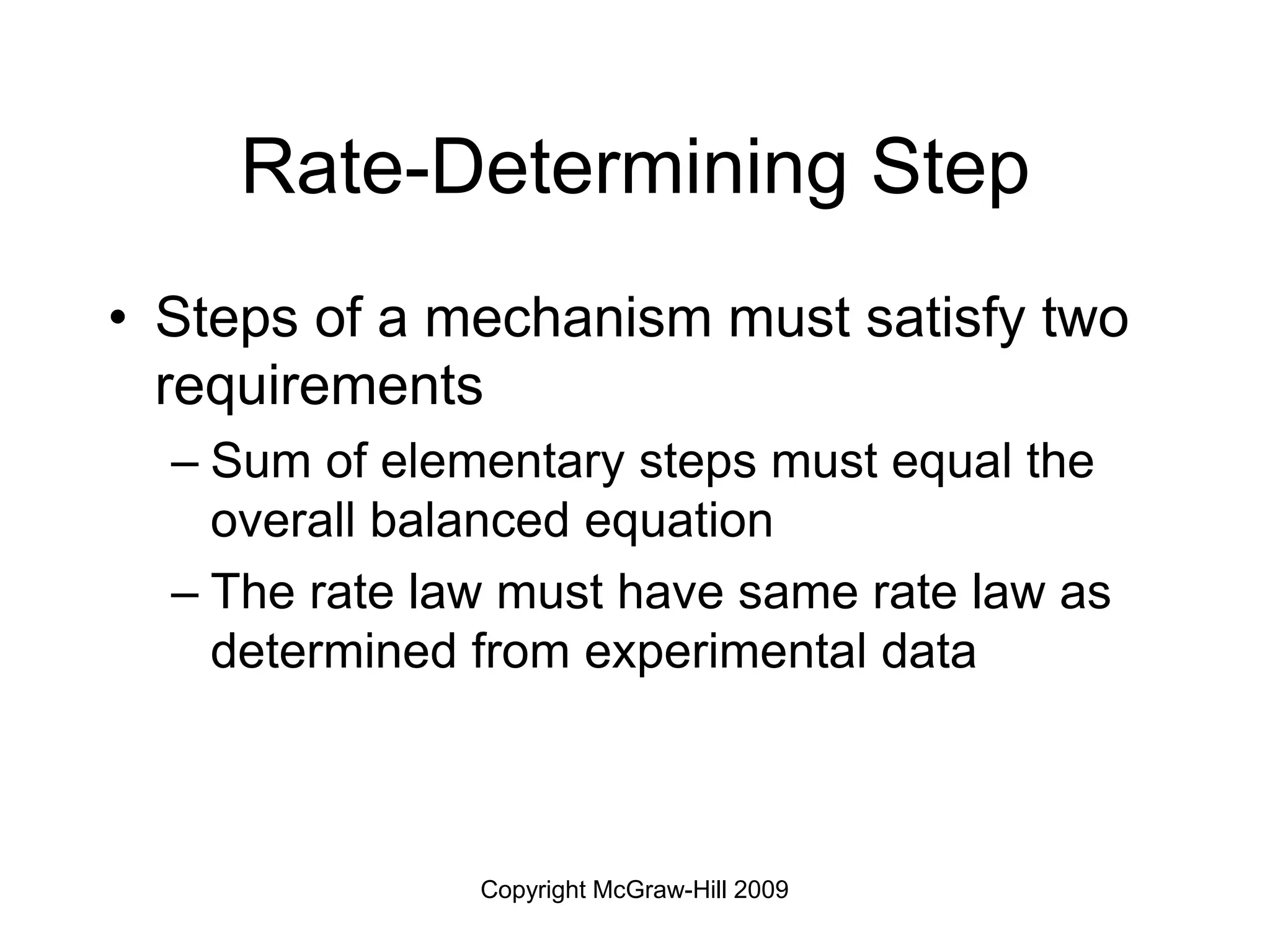
![Copyright McGraw-Hill 2009
• The decomposition of hydrogen
peroxide (2H2O2 2H2O + O2 )
may occur in the following two steps
Step 1: H2O2 + I H2O + IO
Step 2: H2O2 + IO H2O + O2 + I
If step 1 is the rate-determining step, then
the rate law is
rate = k1[H2O2] [I]
k1
¾
¾
k2
¾
¾](https://image.slidesharecdn.com/chapter14lecturefinaljrb-240129164745-16be2f1a/75/chapter14_lecture_finalJRB-ppt-71-2048.jpg)


![Copyright McGraw-Hill 2009
Reaction Mechanism
• Given overall equation:
H2(g) + I2(g) 2HI(g)
Step 1: I2 2I (fast)
Step 2: H2 + 2I 2HI (slow)
rate = k2[H2] [I]2
This rate expression does not meet the
requirement..I is an intermediate and
should not appear in the rate expression
k2
¾
¾
k1
k1
¾
¾
¬ ¾
¾](https://image.slidesharecdn.com/chapter14lecturefinaljrb-240129164745-16be2f1a/75/chapter14_lecture_finalJRB-ppt-74-2048.jpg)
![Copyright McGraw-Hill 2009
• Consider the first equilibrium step: the
forward rate is equal to the reverse rate
k1[I2] = k-1 [I]2 k1/k-1 [I2] = [I]2
If we substitute for [I]2 , the rate law becomes
rate = k[H2] [I2]
This now matches the overall balanced
equation!
(When step 2 is rate-determining this
substitution is always possible)](https://image.slidesharecdn.com/chapter14lecturefinaljrb-240129164745-16be2f1a/75/chapter14_lecture_finalJRB-ppt-75-2048.jpg)
